LA RINASCENTE 1865-2017:
THE HISTORY OF DEPARTMENT STORE
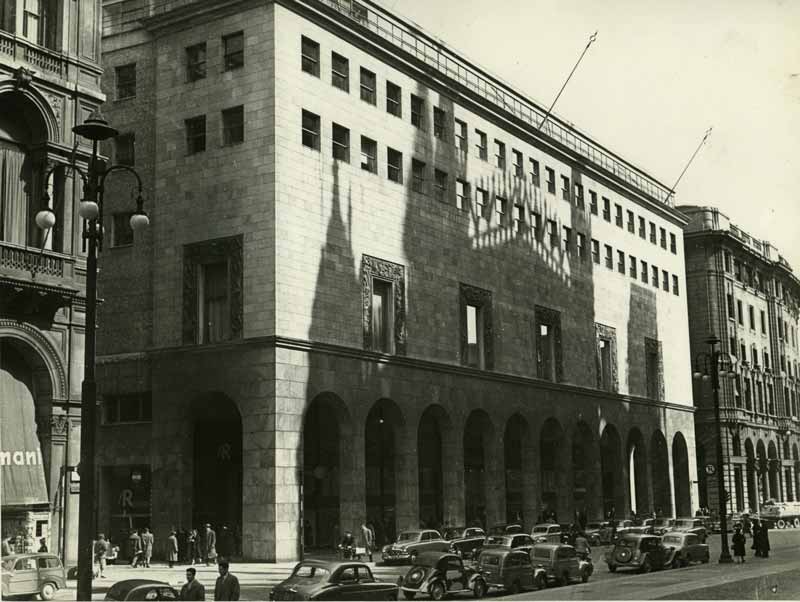
1 — La Rinascente, facciata, s.d.
Touring Club Italiano, Milano
1865
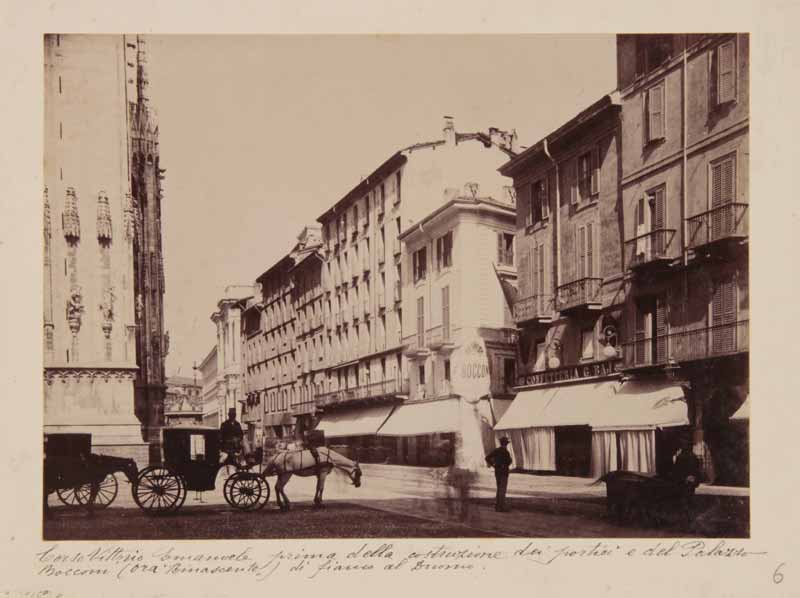
2 — I Magazzini dei Fratelli Bocconi e la Confetteria Bai, 1865-1887
Civico Archivio Fotografico, Milano
On 4 June, the brothers Luigi and Ferdinando Bocconi opened their first fabric and tailoring shop at the corner of Via Santa Radegonda in Milan. By the following year, they were employing more than one hundred workers, tailoring off-the-peg suits for men.
Between 1872 and 1876, they opened branches in Rome’s Via del Corso, in Genoa, Trieste, Palermo and Turin.
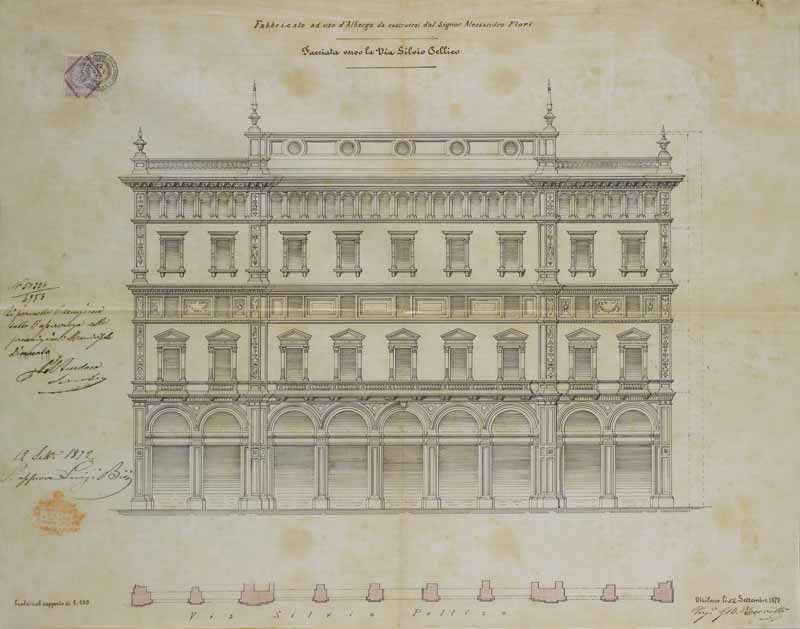
3 — Hotel Confortable, facciata verso via Tommaso Grossi, 1872.
Archivio storico Civico e Biblioteca Trivulziana, Milano
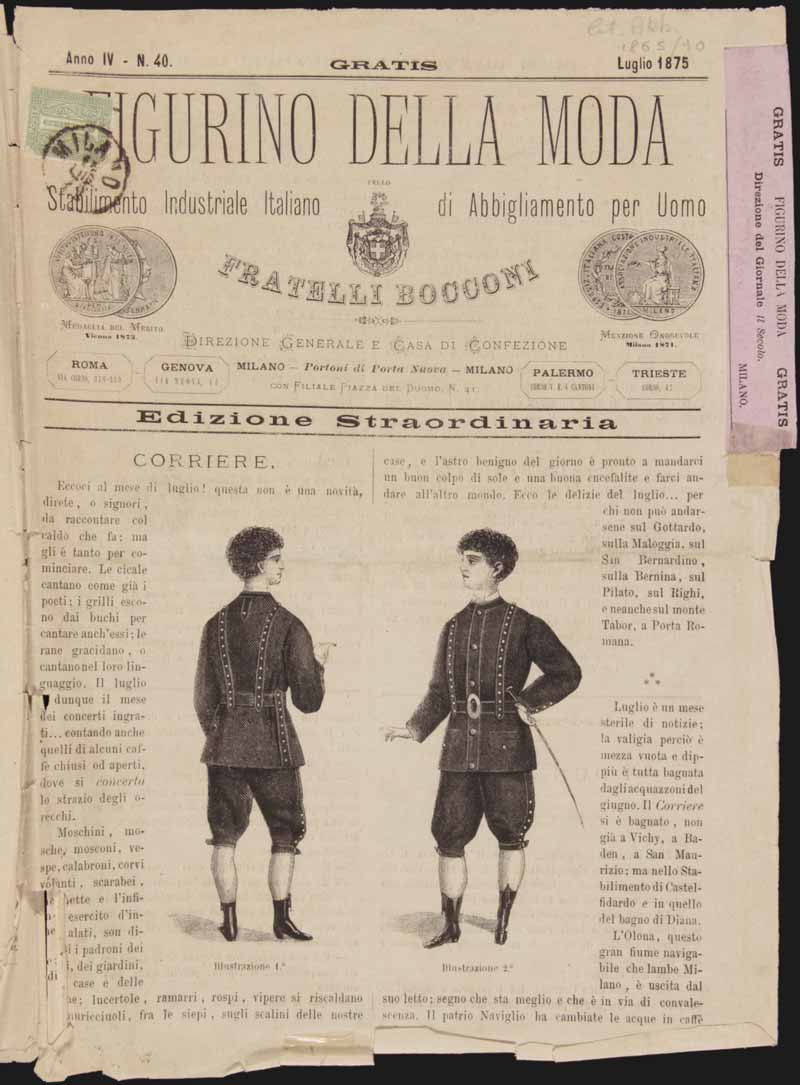
4 — Figurino della moda, a. IV, n. 40, luglio 1875
Civica Raccolta delle Stampe Achille Bertarelli, Milano
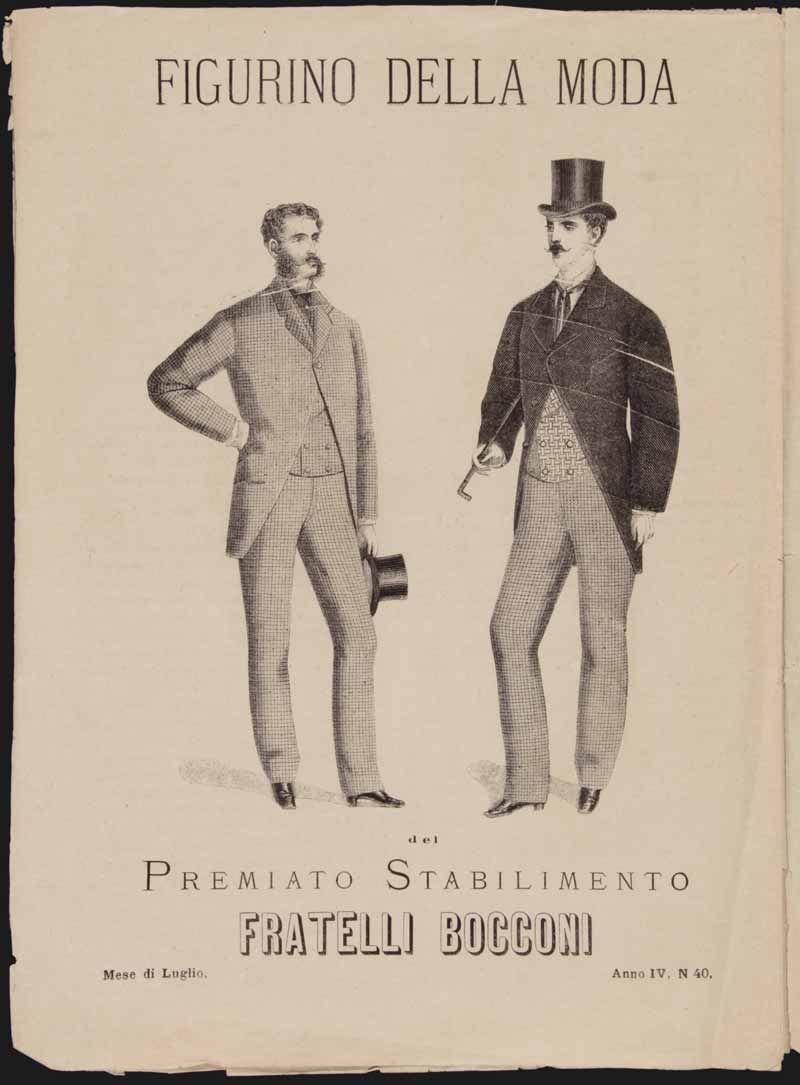
5 — Figurino della moda del Premiato Stabilimento Fratelli Bocconi, a. IV, n. 40, luglio 1875
Civica Raccolta delle Stampe Achille Bertarelli, Milano
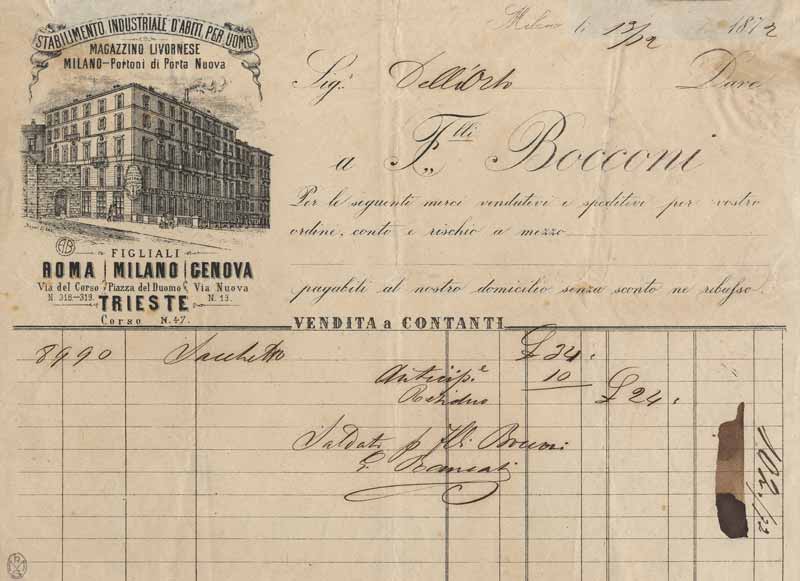
6 — Ricevuta del Magazzino Livornese dei Fratelli Bocconi, 1870 ca.
Civica Raccolta delle Stampe Achille Bertarelli, Milano
1877
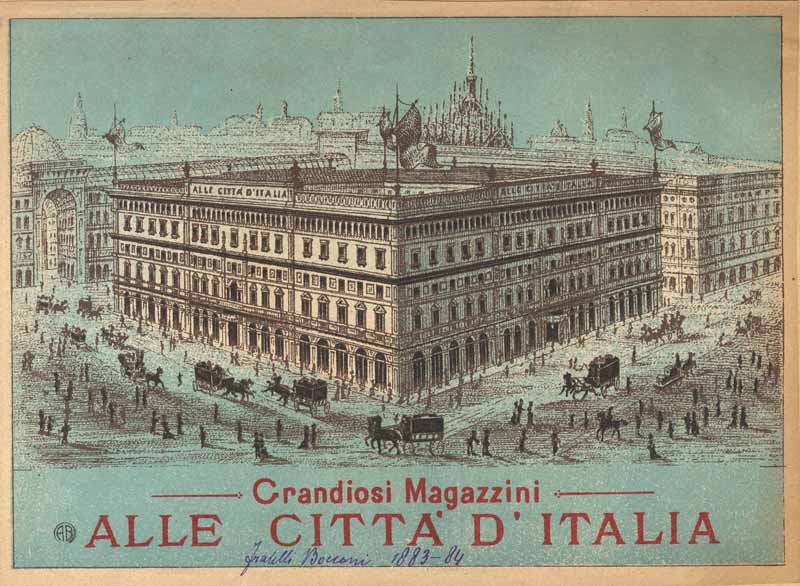
7 — Grandiosi Magazzini Alle Città d’Italia, 1865-1887
Civica Raccolta delle Stampe Achille Bertarelli, Milano
The Bocconi brothers inaugurated the major department store Aux Villes d’Italie at the Hôtel Confortable. The first of its kind in Italy, it was modelled on Aristide Boucicaut’s store Le Bon Marché in Paris (1852), made famous by Émile Zola in his novel Au Bonheur des Dames (1883). In 1880 the sign was changed to the Italian version of the name, Alle Città d’Italia. In 1887, the brothers opened their new store in Rome’s Piazza Colonna, designed by Giulio De Angelis, and in 1889 the new store in Milan’s Piazza Duomo, designed by Giovanni Giachi.
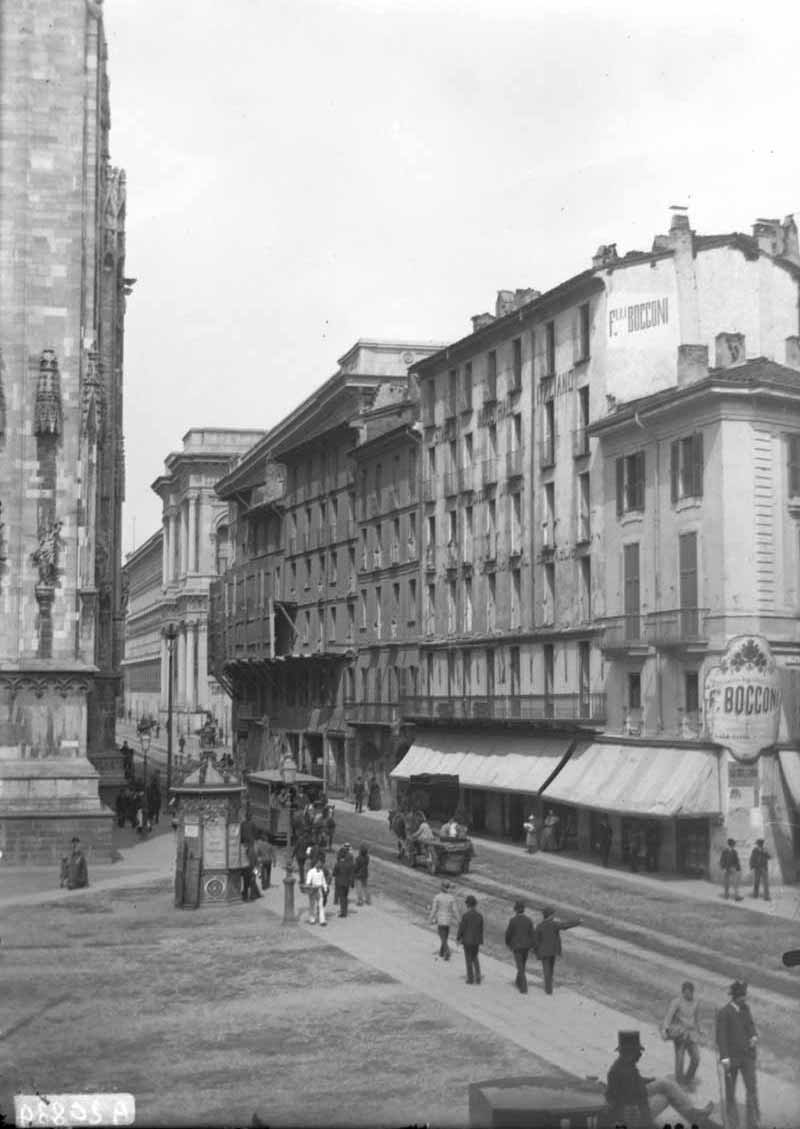
8 — Corso Vittorio Emanuele II con veduta dei Magazzini Bocconi, 1865-1887
Civico Archivio Fotografico, Milano
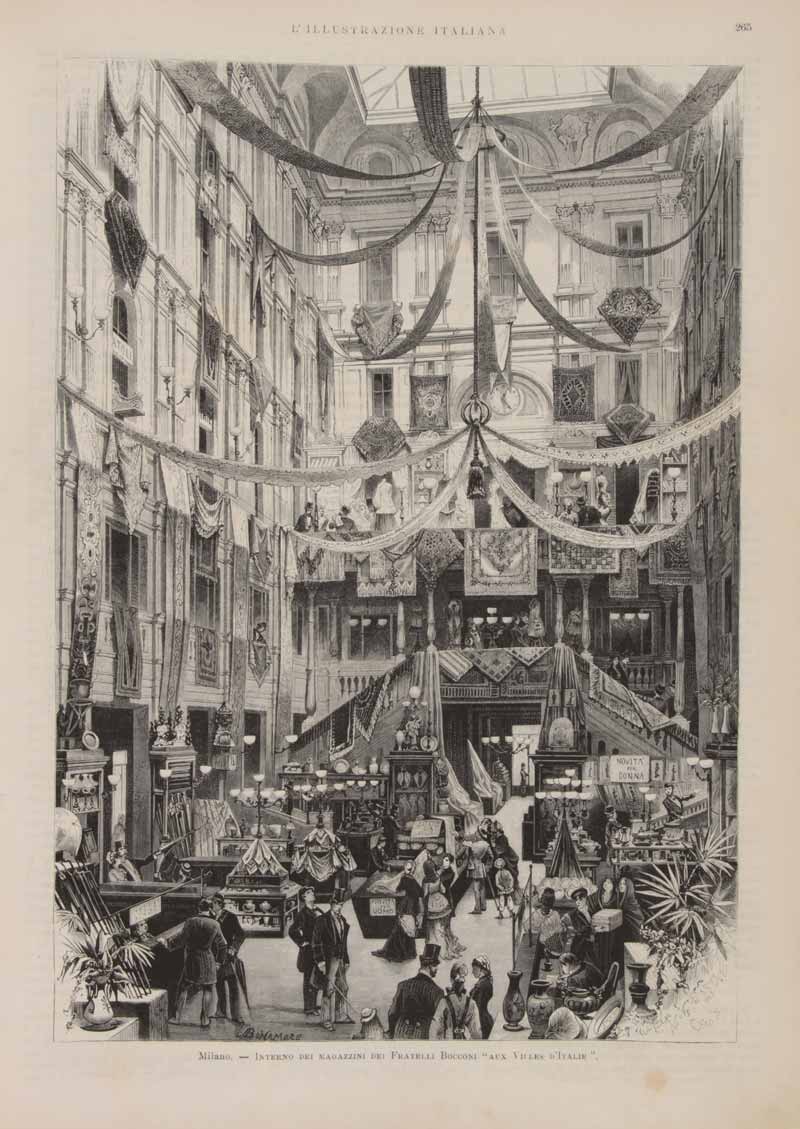
9 — Interno dei Magazzini dei Fratelli Bocconi “Aux Villes d’Italie”, in “L’Illustrazione Italiana”, a. VI, n. 17, 27 aprile 1879
Civica Raccolta delle Stampe Achille Bertarelli, Milano
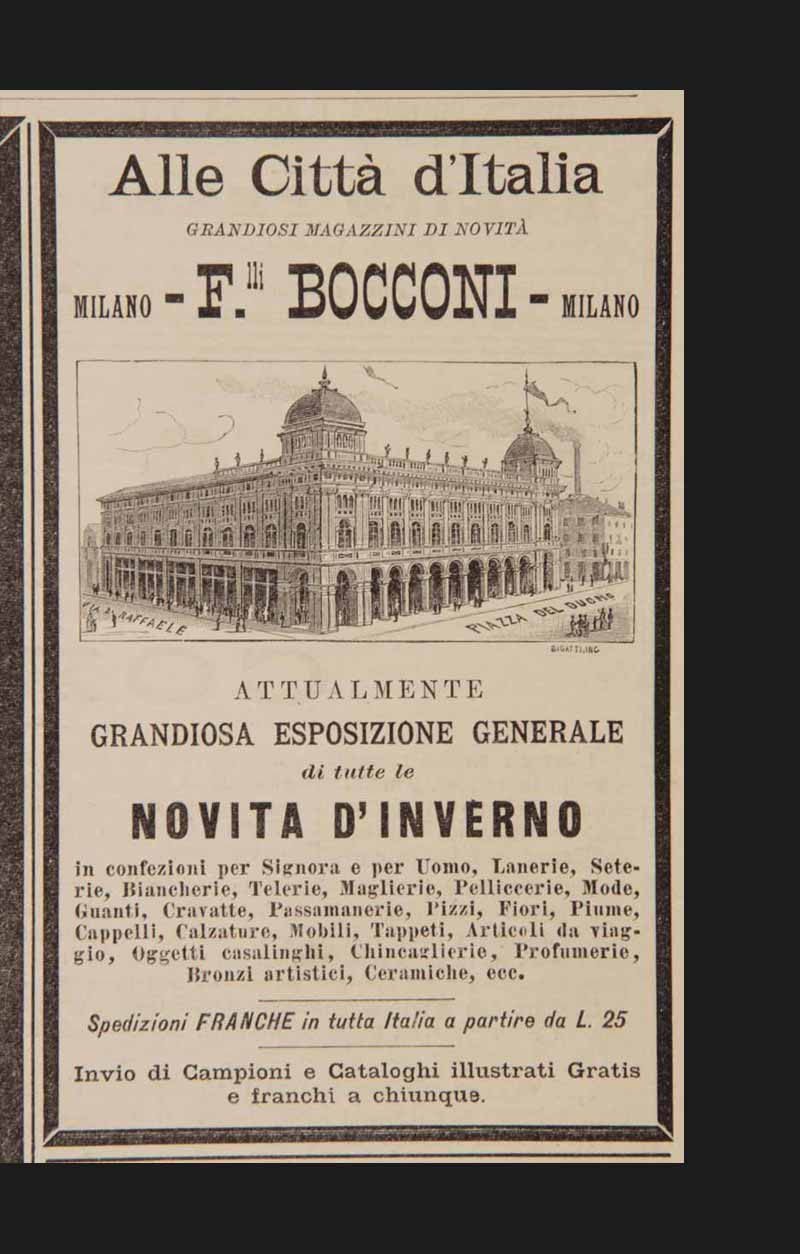
10 — Annuncio pubblicitario dei Magazzini Alle Città d’Italia, in “L’Illustrazione Italiana”, a. XVI, n. 47, 24 novembre 1889
Civica Raccolta delle Stampe Achille Bertarelli, Milano
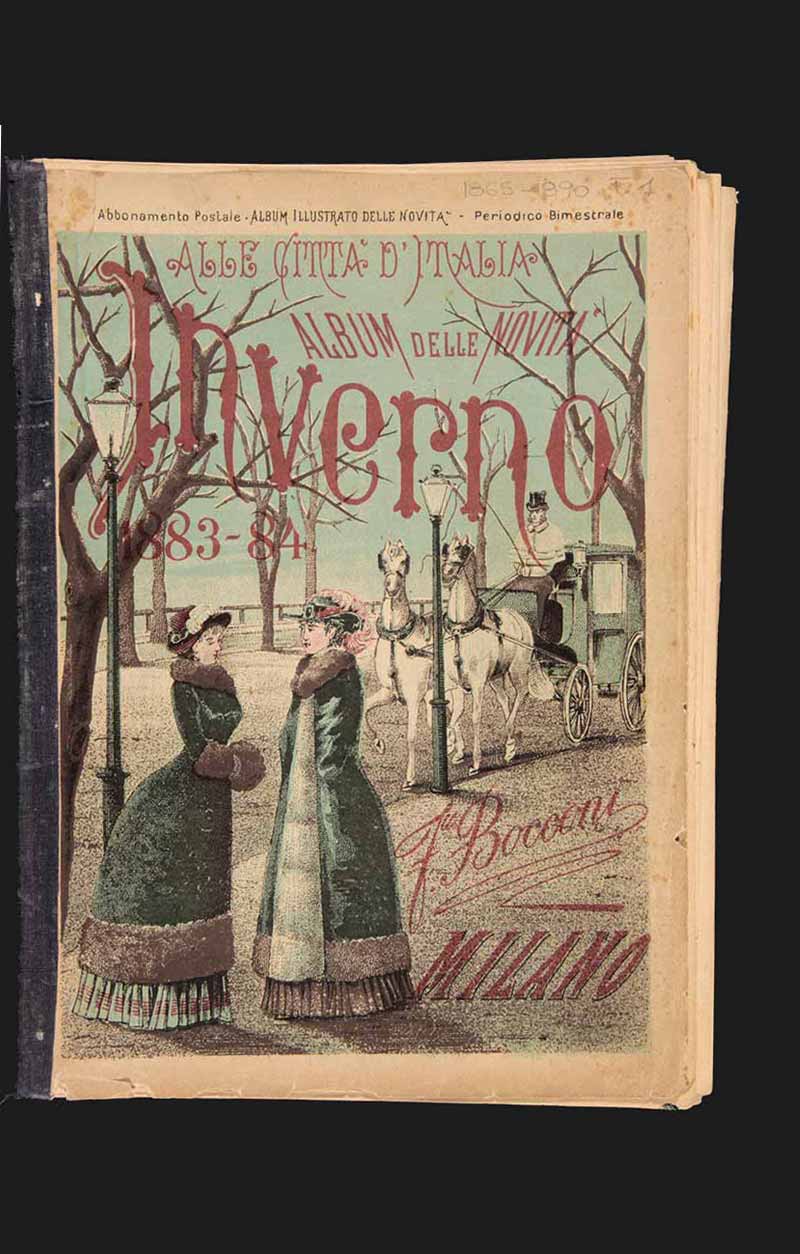
11 — Alle Città d’Italia. Album delle novità, inverno 1883-84, 1883
Civica Raccolta delle Stampe Achille Bertarelli, Milano

12 — Grandiosi Magazzini di Novità Aux Villes d'Italie, Fratelli Bocconi 1879-1880, 1879
Civica Raccolta delle Stampe Achille Bertarelli, Castello Sforzesco, Milano

13 — Aleardo Villa, Fratelli Bocconi Milano. Grandi Magazzini di Novità Alle Città d’Italia, 1898 ca.
Civica Raccolta delle Stampe Achille Bertarelli, Milano
1917
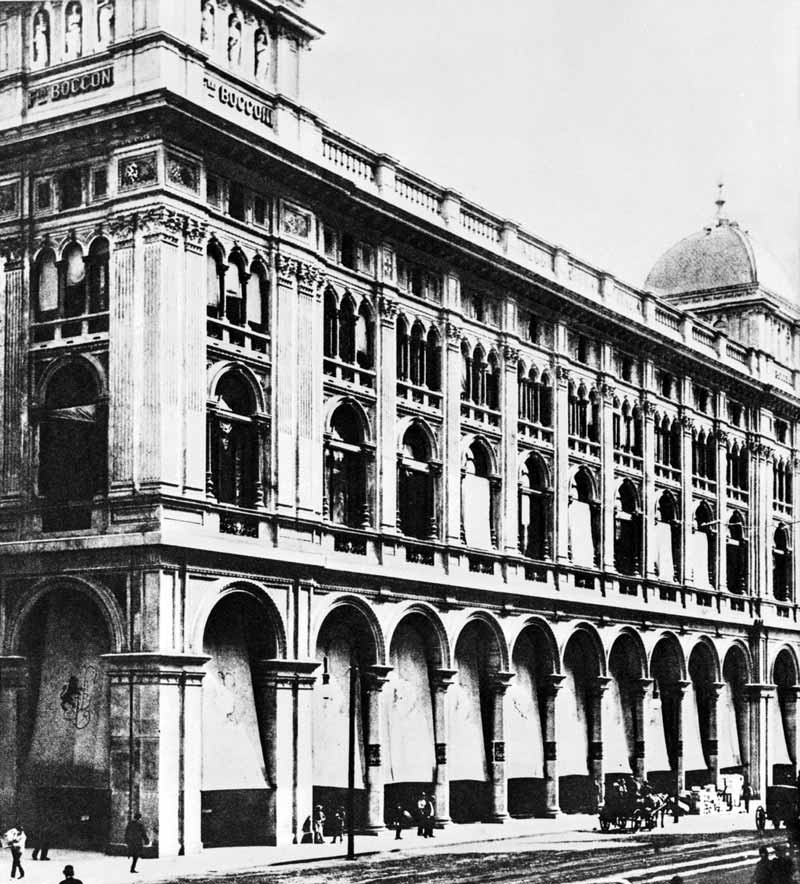
14 — I Magazzini Fratelli Bocconi poco prima di diventare la Rinascente, 1917
Archivi Farabola, Vaiano Cremasco
The Bocconi Stores were sold to Senatore Borletti, who entrusted Gabriele D’Annunzio with creating the new name. This is how the joint stock company La Rinascente was born and was officially registred on 27th September 1917. La Rinascente opened to the public on 7 December 1918, in the building in Piazza del Duomo, which was destroyed in a fire a few days after the inauguration.
In 1919 and 1920, the branches in Turin, Genoa, Bologna, Florence, Rome, Naples and Palermo all reopened after renovation.

15 — Statuto della Società Anonima "La Rinascente", 1917
Archivio Brustio-La Rinascente - Università Commerciale Luigi Bocconi, Milano

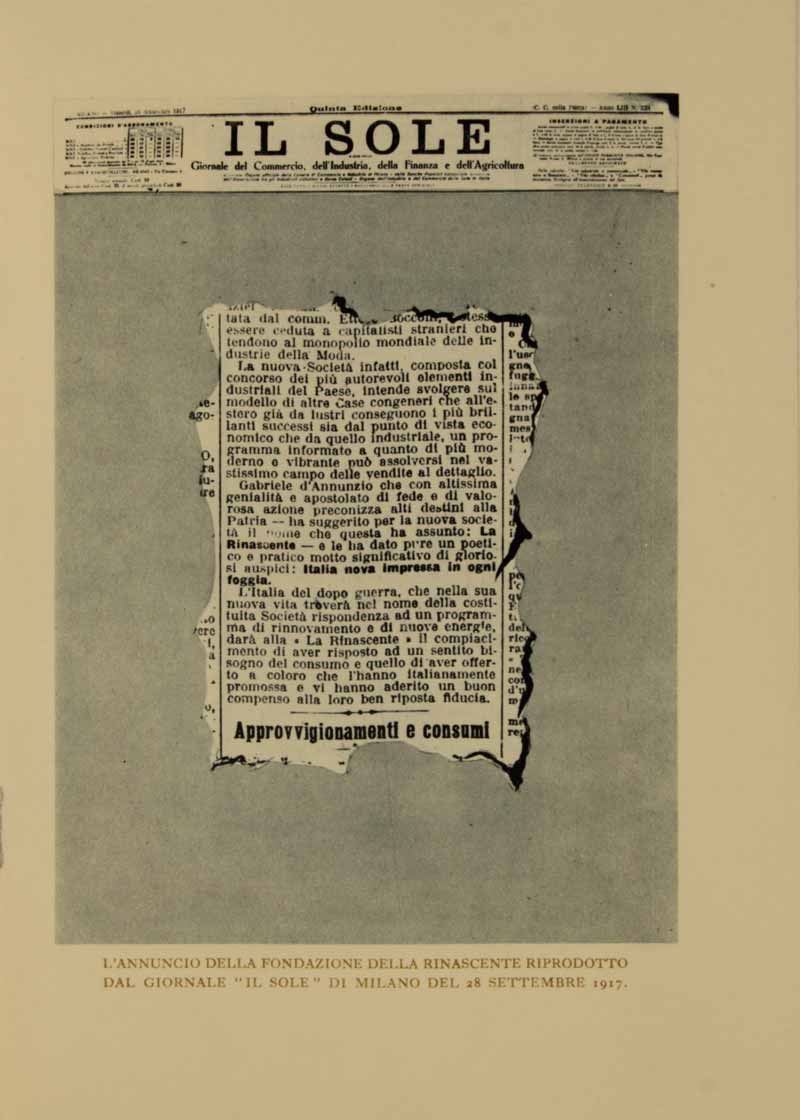
16/17 — Cronaca cittadina. La costituzione di una grande impresa nazionale di rinascimento commerciale, in “Il Sole”, a. LIII, n. 231, settembre 1917
Archivio Brustio-La Rinascente - Università Commerciale Luigi Bocconi, Milano
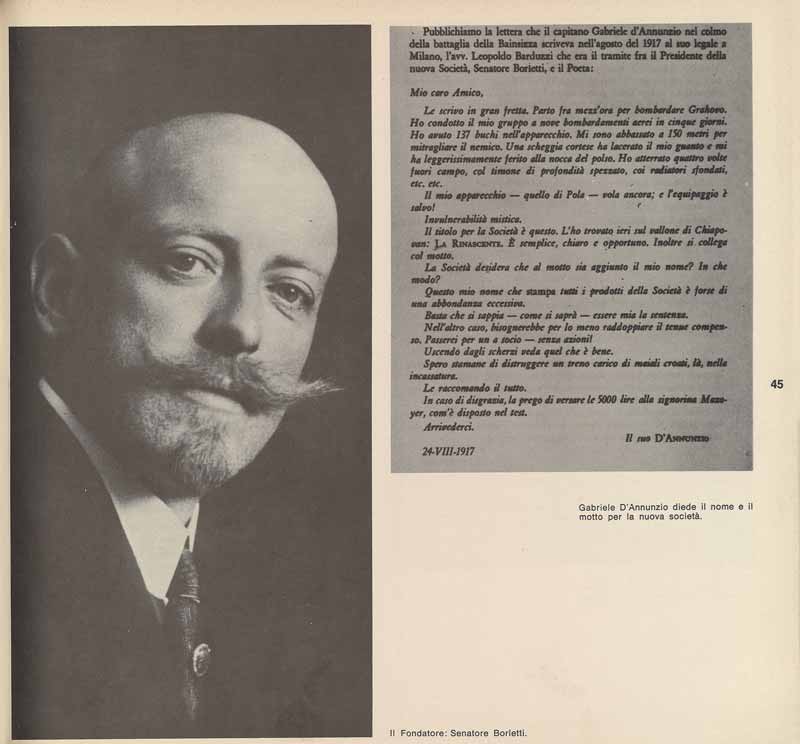
18 — Lettera di Gabriele D’annunzio all’avv. Barduzzi, in “Cronache laRinascente upim”, a. XX, n. 42, 1967
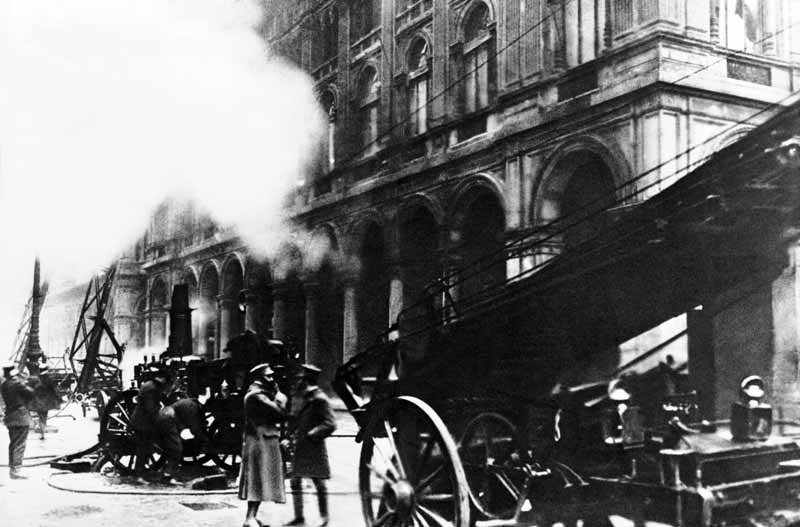
19 — La Rinascente durante l’incendio, 1918
Archivi Farabola, Vaiano Cremasco

20 — Il palazzo de la Rinascente ripreso dall’alto dopo l’incendio, 1918
Civico Archivio Fotografico, Milano
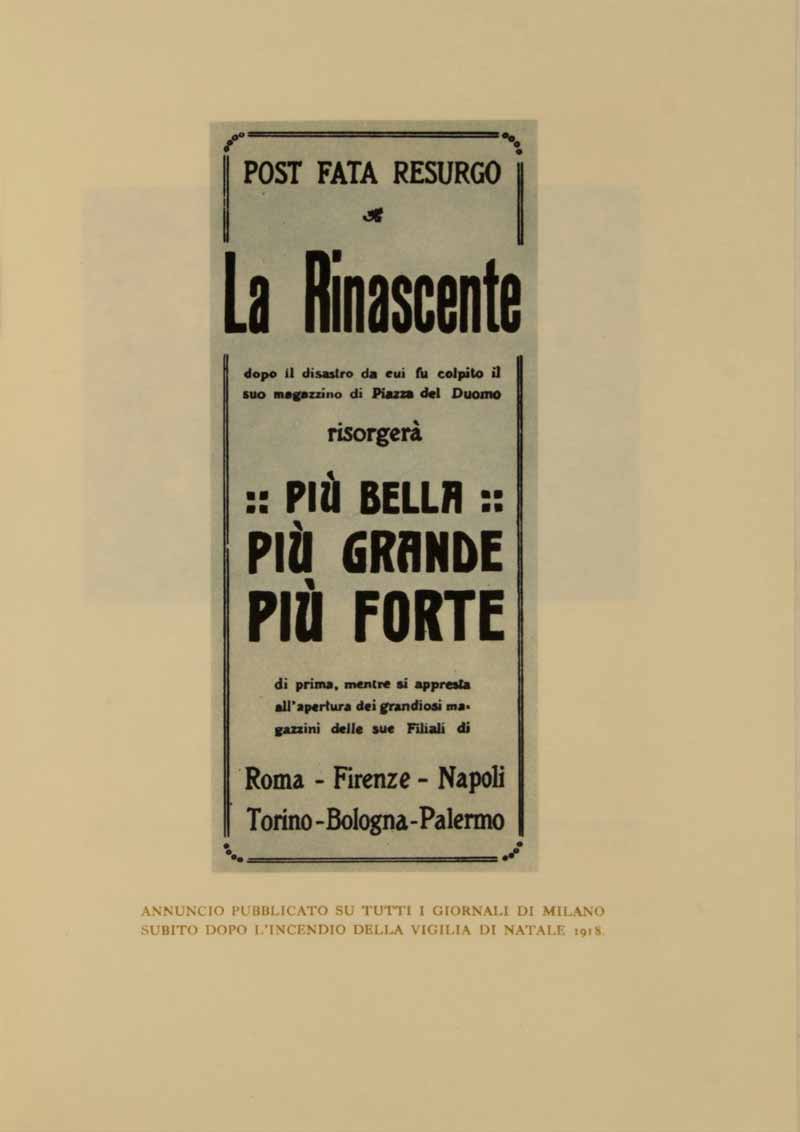
21 — Post fata resurgo, 1918
Archivio Brustio-La Rinascente - Università Commerciale Luigi Bocconi, Milano
1921
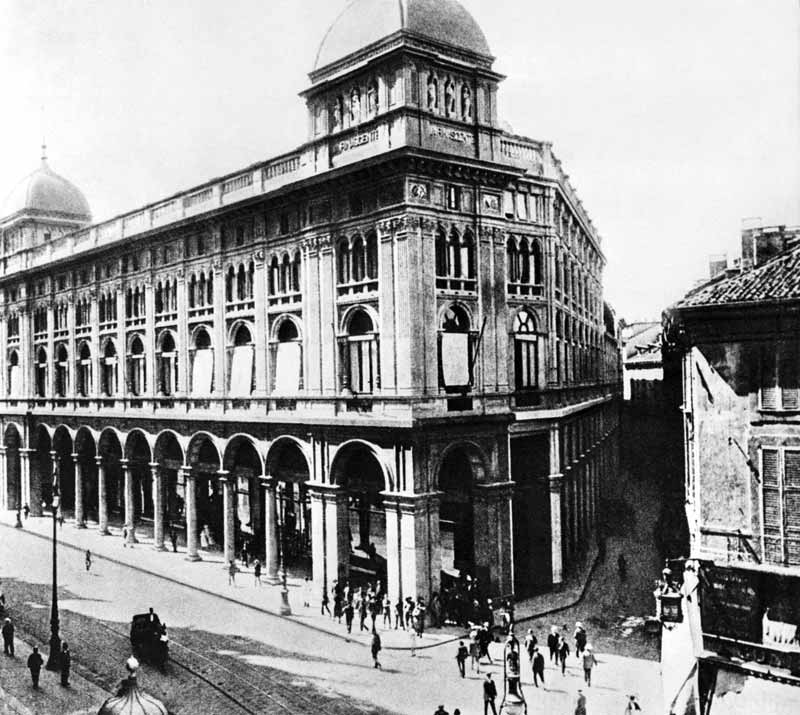
22 — La Rinascente dopo la ricostruzione in seguito all'incendio, 1921
Archivi Farabola, Vaiano Cremasco
La Rinascente’s building in Milan’s Piazza del Duomo was inaugurated on 23 March after reconstruction that had transformed it and made it larger. The management of the company as a whole was in the hands of Umberto Brustio, the brother-in-law of the major shareholder Senator Borletti.
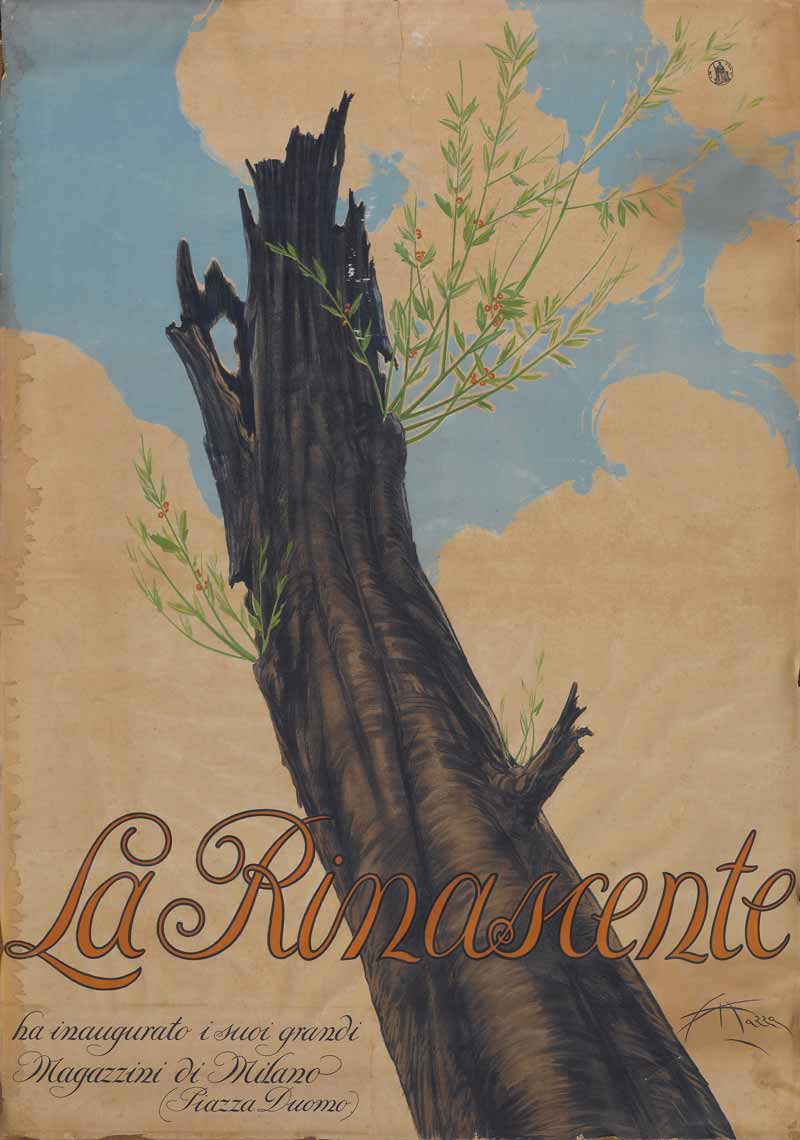
23 — Aldo Mazza, La Rinascente ha inaugurato i suoi grandi Magazzini di Milano (Piazza Duomo), 1921
Archivio la Rinascente, Milano

24 — Marcello Dudovich, La Rinascente. Articoli per villeggiatura, 1923-1926
Civica Raccolta delle Stampe Achille Bertarelli, Milano
The celebrated poster created by Aldo Mazza to mark the reopening of the stores, which depicts new branches budding from the trunk of an olive tree, is a reference to the symbolic concept of rebirth. In this period, a successful relationship developed between La Rinascente and Marcello Dudovich. The artist from Trieste was to continue creating advertising posters for the company until 1956.
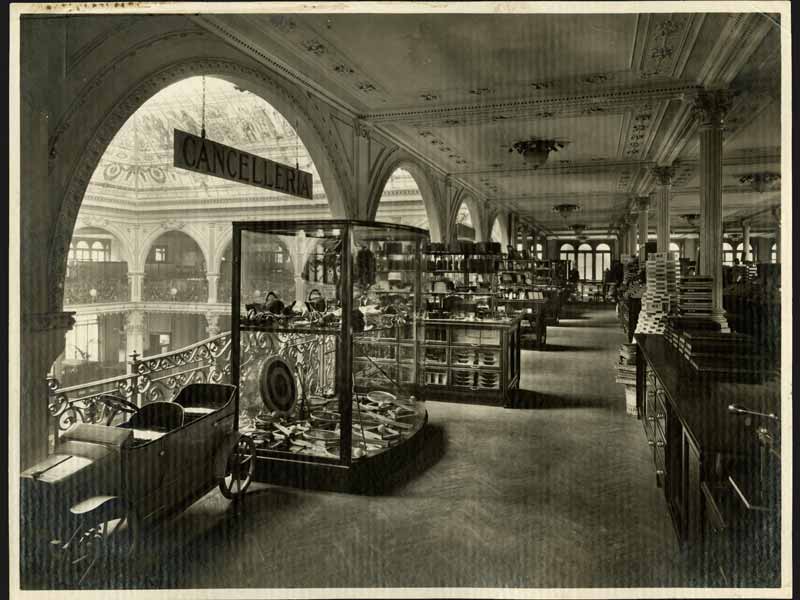
25 — Reparti di vendita dei grandi magazzini La Rinascente, 1920 ca.
Touring Club Italiano, Milano
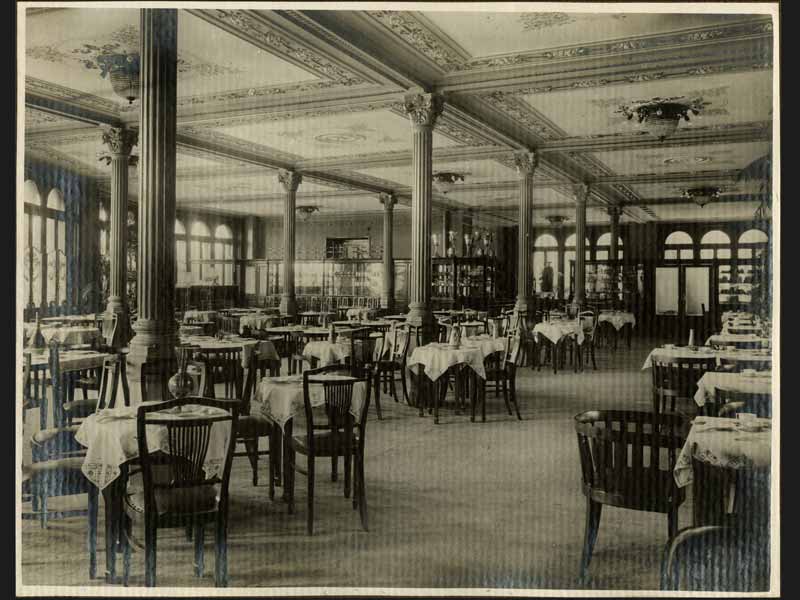
26 — Il ristorante dei grandi magazzini La Rinascente, 1920 ca.
Touring Club Italiano, Milano
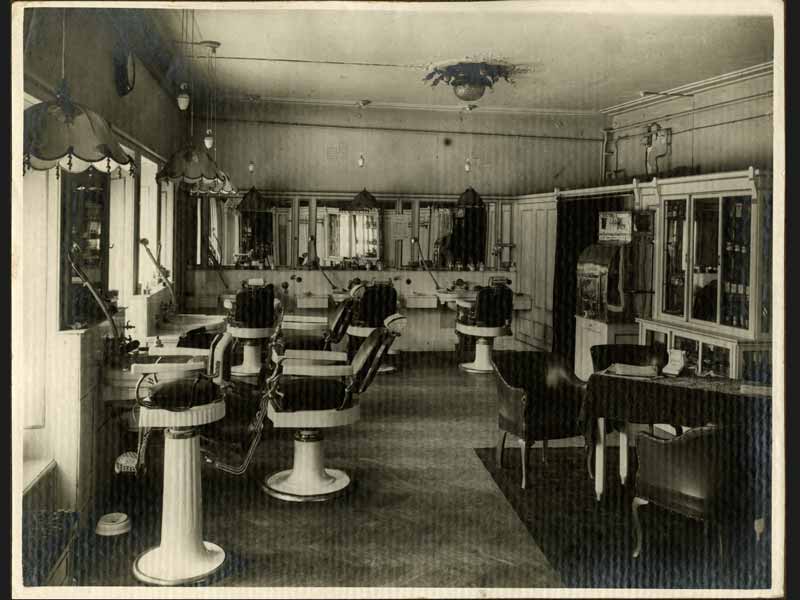
27 — La sala da barbiere dei grandi magazzini La Rinascente, 1920 ca.
Touring Club Italiano, Milano
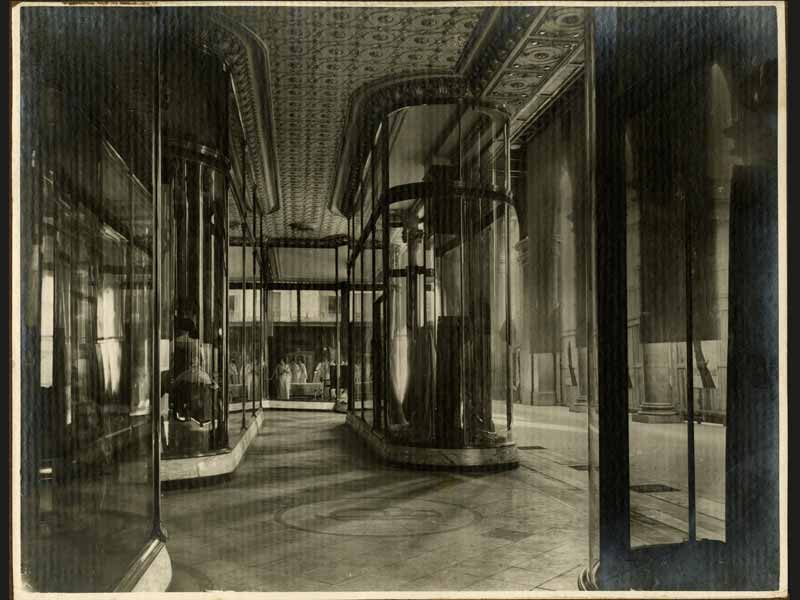
28 — Le vetrine su piazza Duomo dei grandi magazzini La Rinascente, 1920 ca.
Touring Club Italiano, Milano
1927
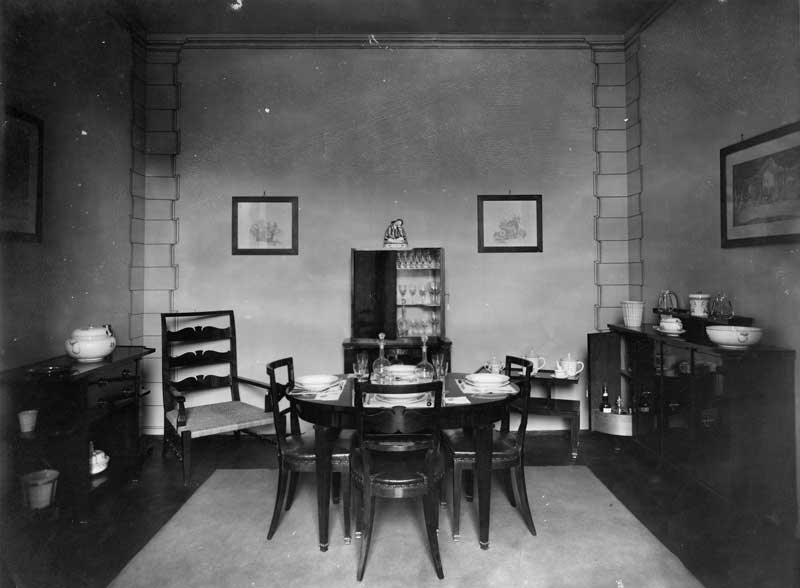
29 — Gio Ponti, Emilio Lancia, Sala da pranzo, Domus nova, 1927
Fondazione La Triennale di Milano - Biblioteca del Progetto e Archivio Storico
Gio Ponti, assisted by Emilio Lancia, designed the Domus Nova series of modern furnishings, produced and sold by La Rinascente. The purpose of this new series was to update the look of Italy’s middle-class homes and the furnishings in them. The décor was simple in form, yet elegant, and was produced to furnish four rooms: a family room, a dining room, a master bedroom and a young girls’ bedroom. All of them were put on show at the III Monza Biennale.
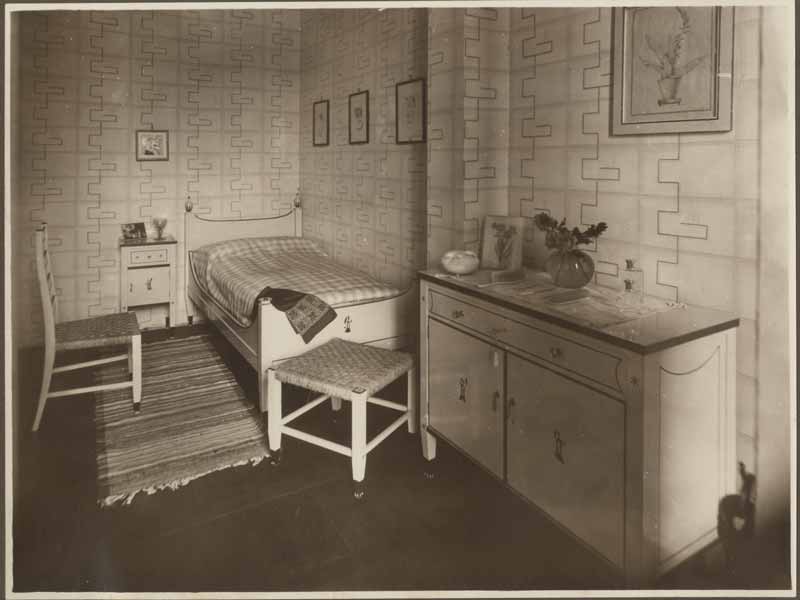
30 — Gio Ponti, Emilio Lancia, Camera per signorina, Domus nova, 1927
Fondazione La Triennale di Milano - Biblioteca del Progetto e Archivio Storico
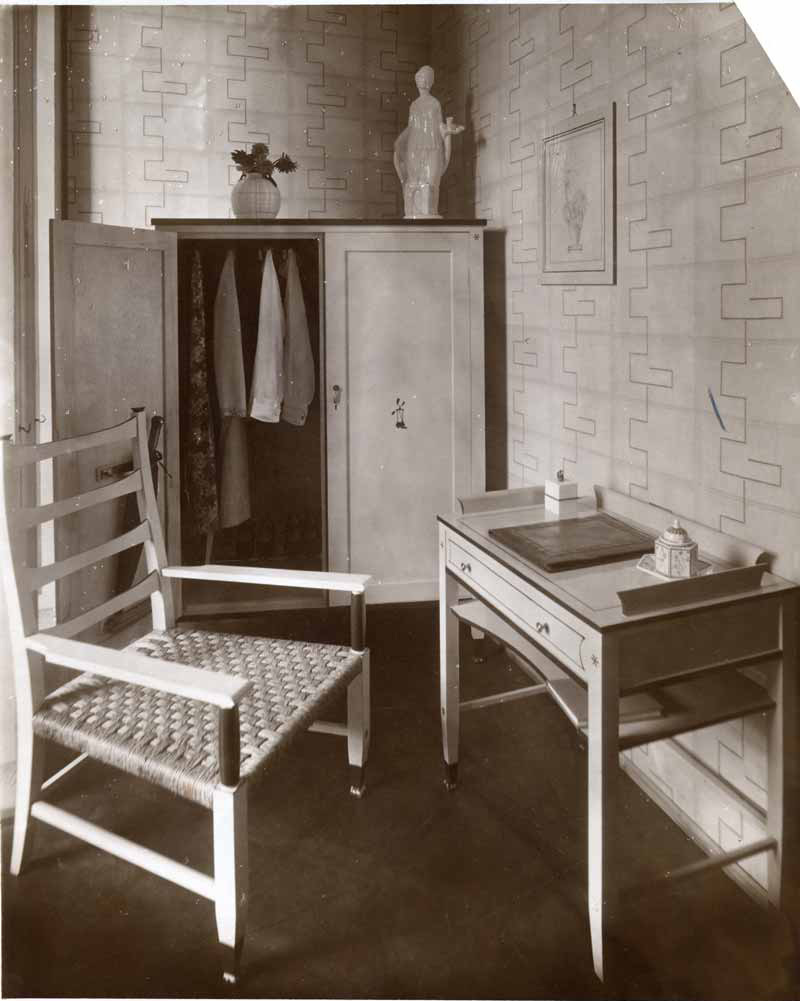
31 — Gio Ponti, Emilio Lancia, Camera per signorina, Domus nova, 1927
Fondazione La Triennale di Milano - Biblioteca del Progetto e Archivio Storico

32 — La Rinascente, autunno inverno 1926-1927, 1926
Civica Raccolta delle Stampe Achille Bertarelli, Milano
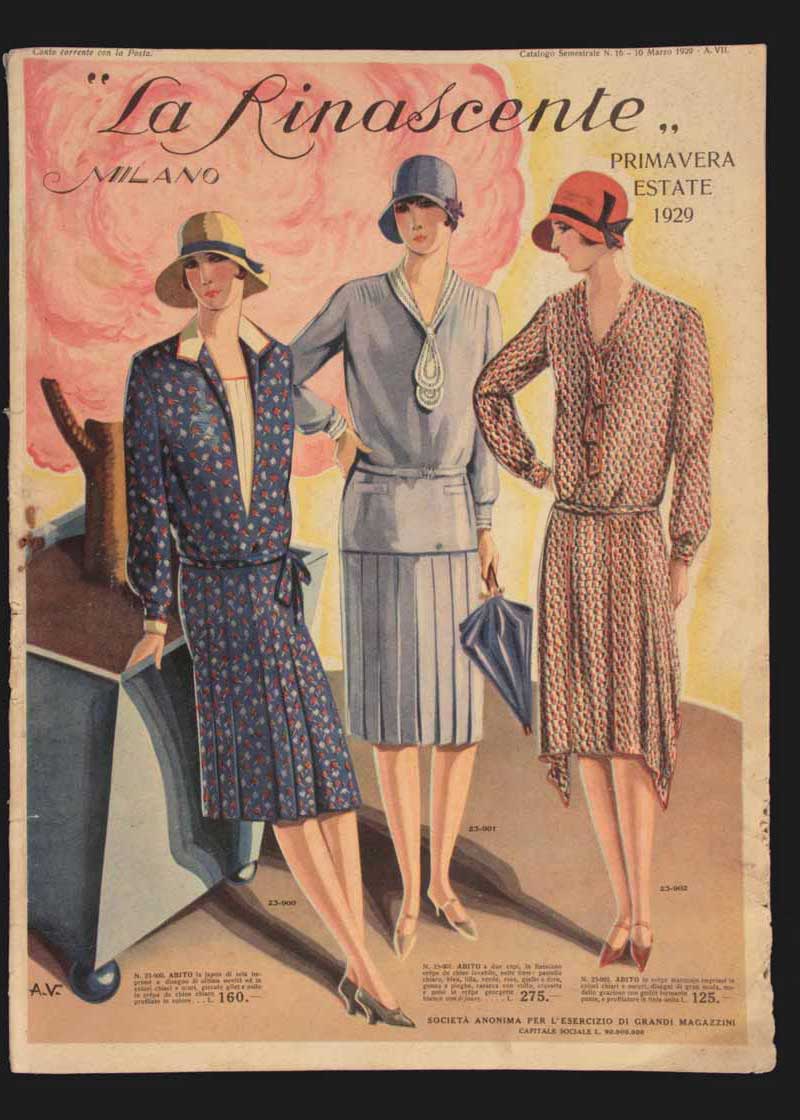
33 — La Rinascente. Primavera estate 1929, 1929
Touring Club Italiano, Milano
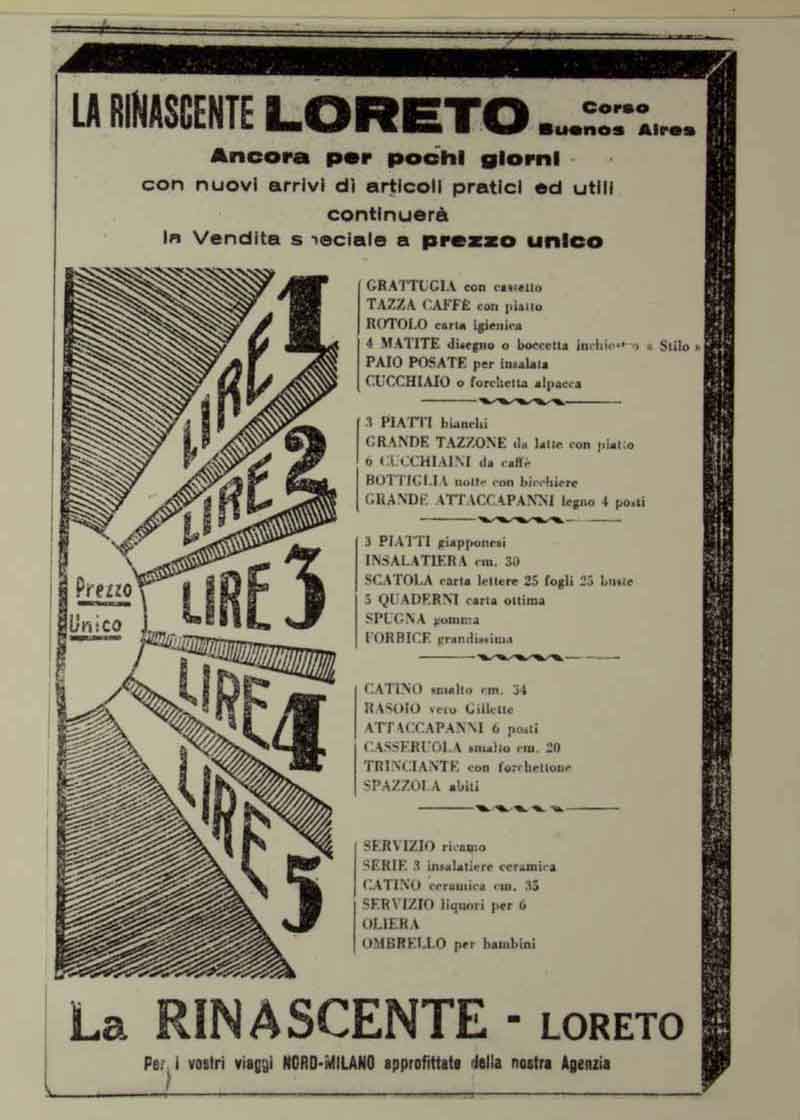
34 — La Rinascente Loreto, 1928
Archivio Brustio-la Rinascente
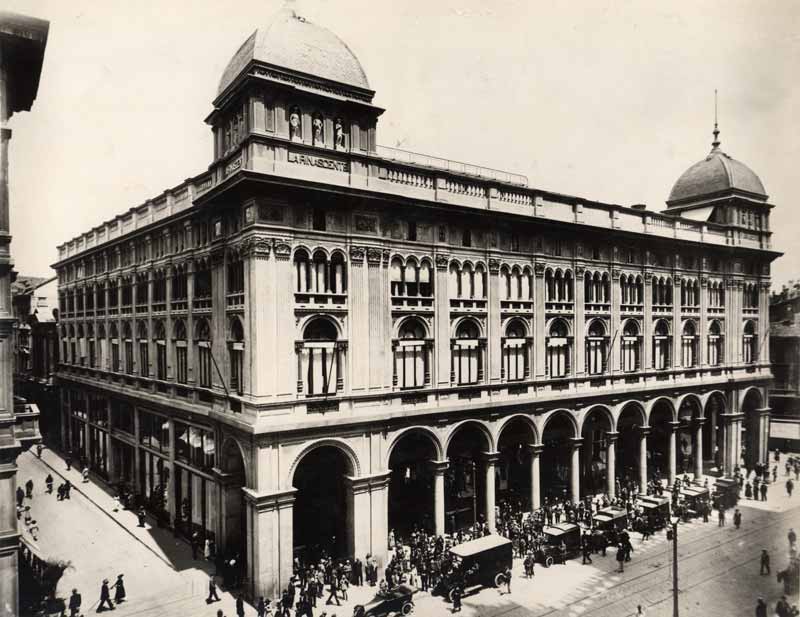
35 — Progetto per il sopralzo e l’ampliamento dei grandi magazzini La Rinascente in P.zza Duomo, 1928-1929
Fondazione Piero Portaluppi, Milano
1934
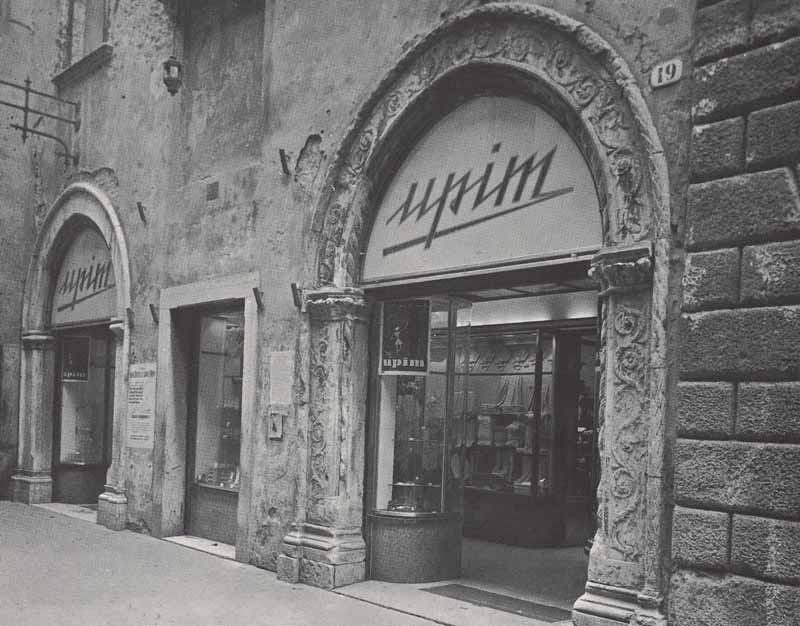
36 — Magazzino Upim, 1928, in “La Rinascente: cinquant'anni di vita italiana. Volume secondo”
Archivio Amneris Latis, Milano
After partnering with the German company Leonhard Tietz to introduce the single-price store into Italy, La Rinascente merged with Upim stores to create a single company. One of the partners in this new venture, which numbered five branches of La Rinascente and twenty-five Upim stores all over Italy, was the Jelmoli major department store based in Zurich.
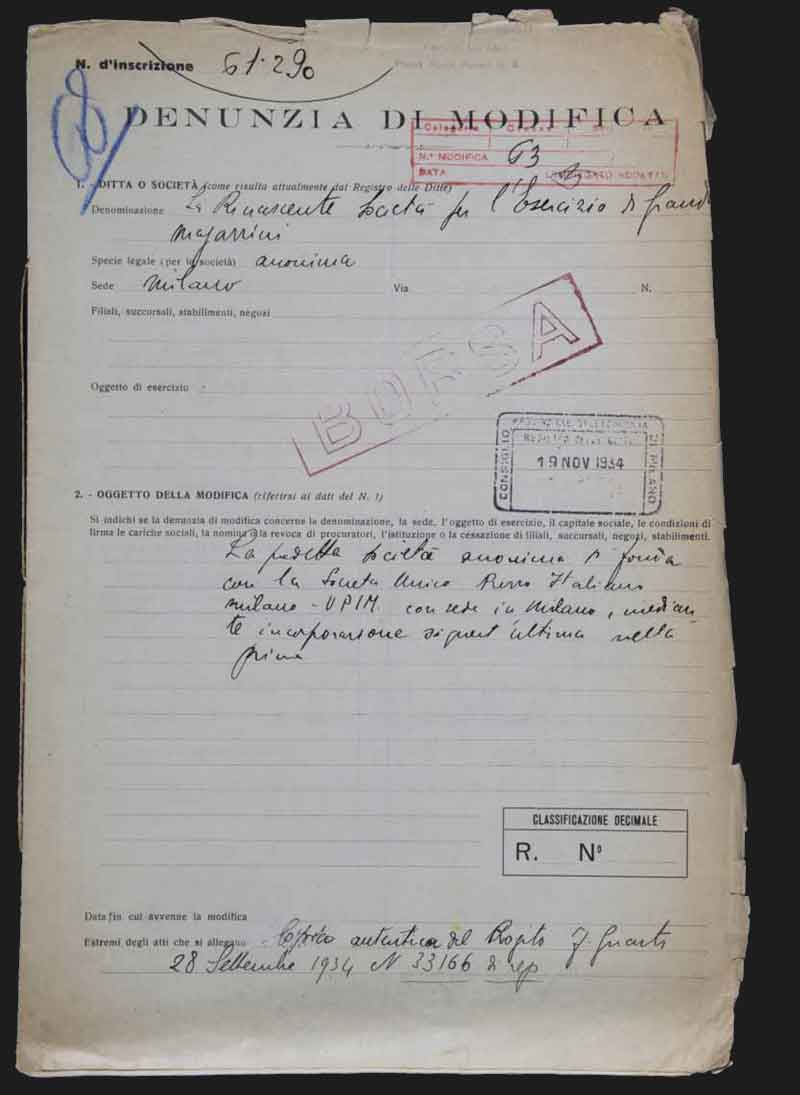
37 — Atto di Fusione la Rinascente-UPIM, 1934
Archivio Storico della Camera di Commercio, Milano
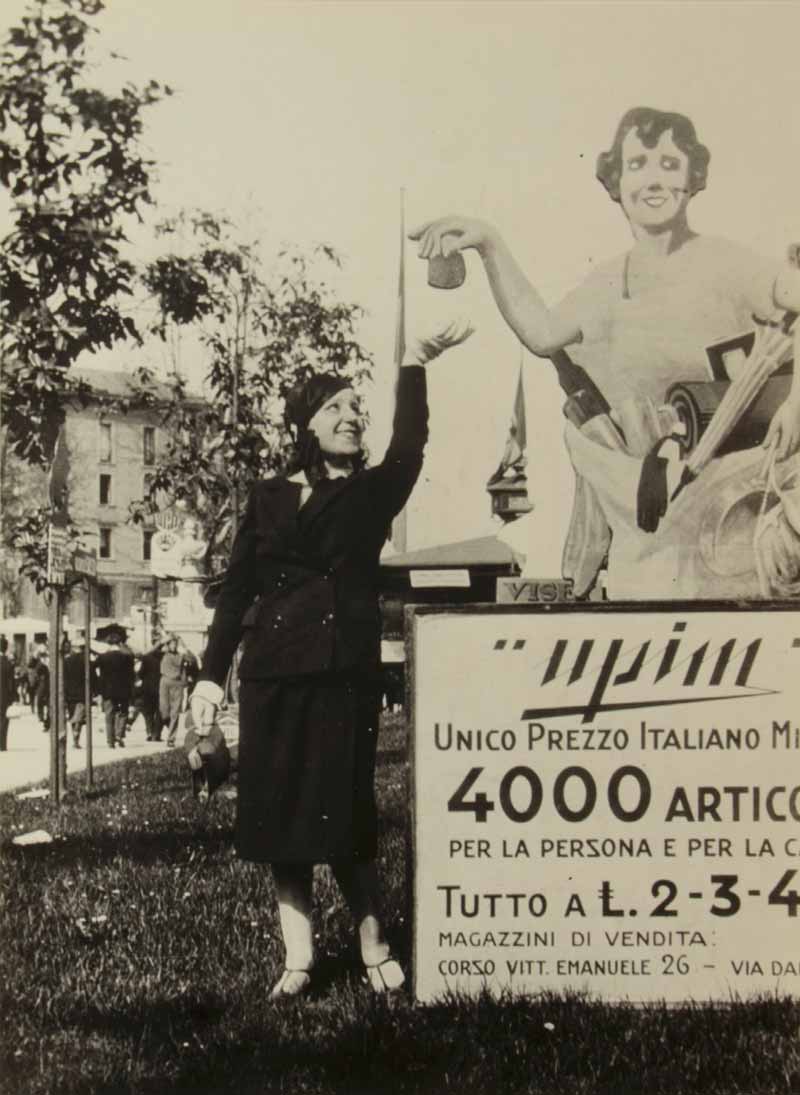
38 — Il primo cartello pubblicitario della Upim alla Fiera di Milano, 1930
Archivio Brustio-La Rinascente, Università Commerciale Luigi Bocconi
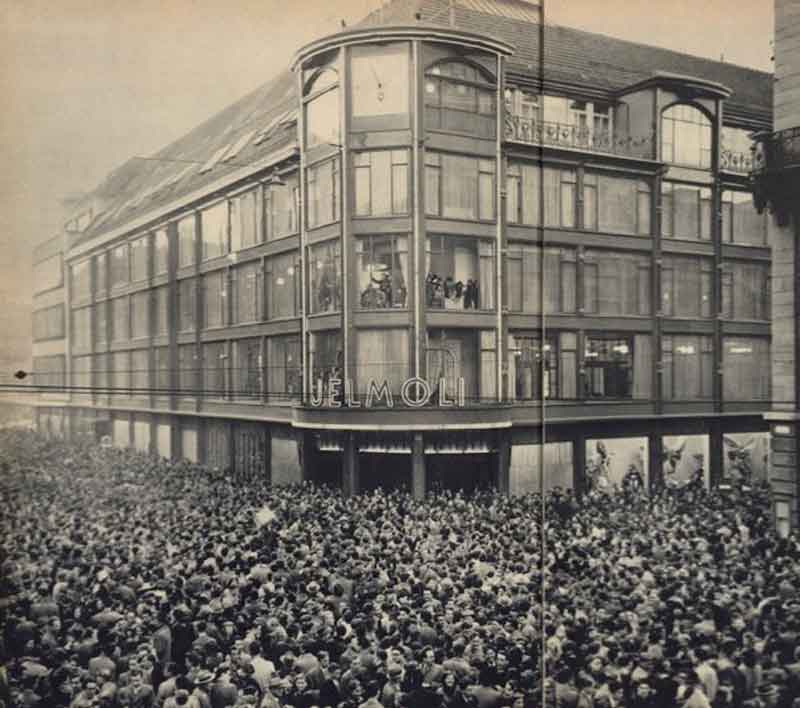
39 — I Magazzini Jelmoli, in “Cronache laRinascente-Upim”, a. XII, n. 12, 1958
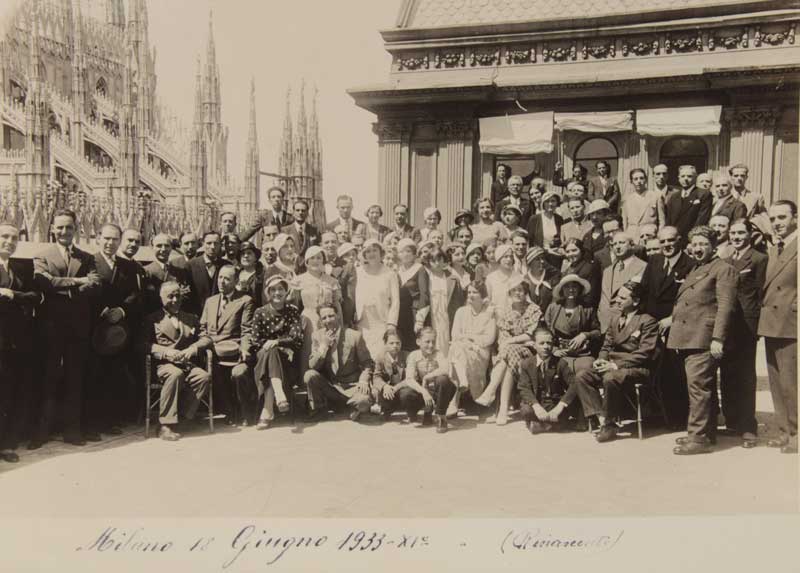
40 — Milano 18 Giugno 1933 - Rinascente
Collezione Michele Rapisarda, Milano
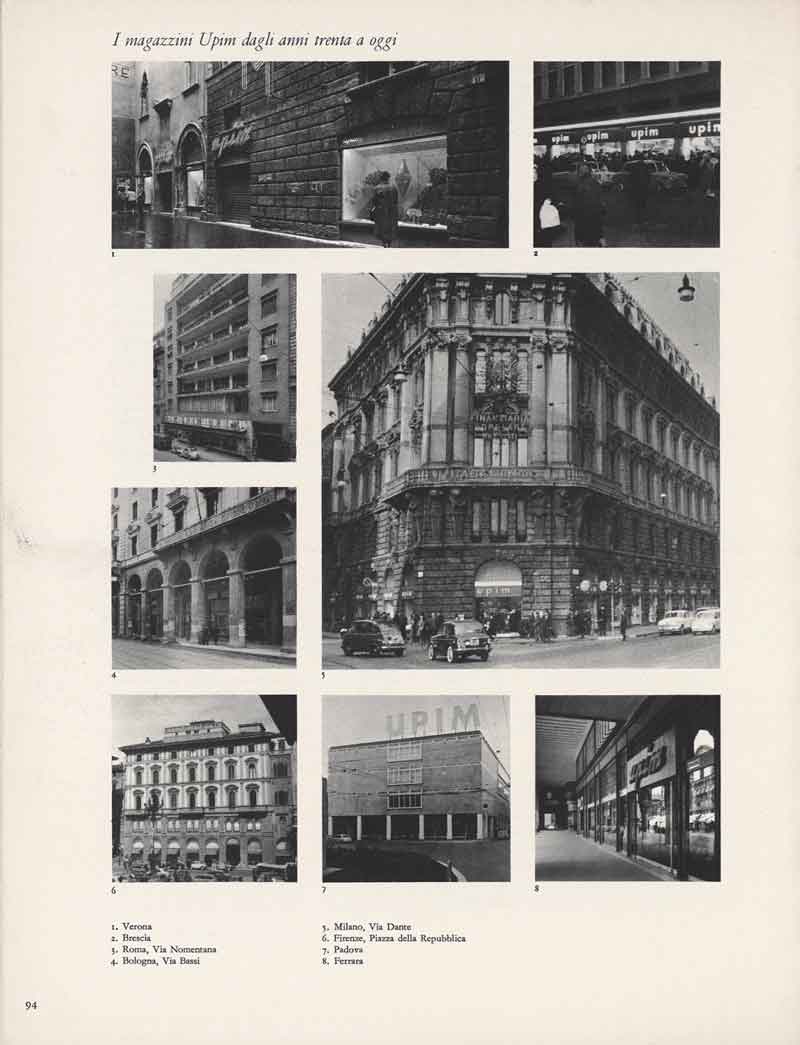

41/42 — I Magazzini Upim, 1928-1935, in “La Rinascente: cinquant'anni di vita italiana. Volume secondo”
Archivio Amneris Latis, Milano
1937
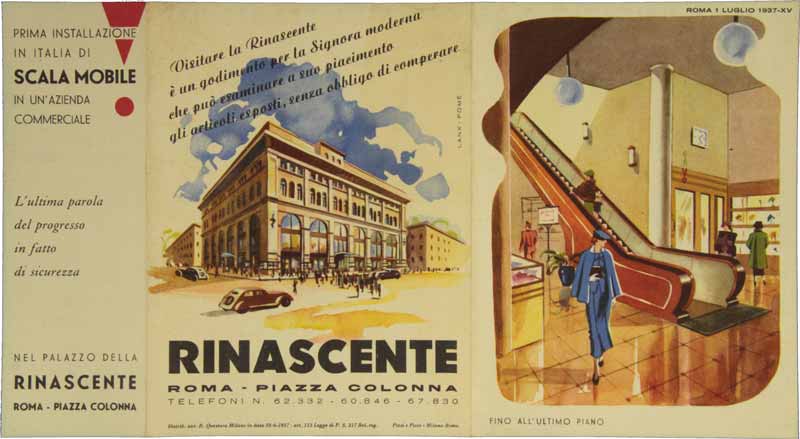
x43/44 — Rinascente Roma Piazza Colonna, 1937
Collezione Michele Rapisarda, Milano
An escalator was installed in La Rinascente’s store in Piazza Colonna, Rome: it was the first escalator to be installed in a commercial building in Italy.
These were the years when Italian products were launched and came in for fulsome praise, synthetic materials were much admired and rayon, cafioc (a substitute for cotton, made from hemp) and artificial wool were introduced.
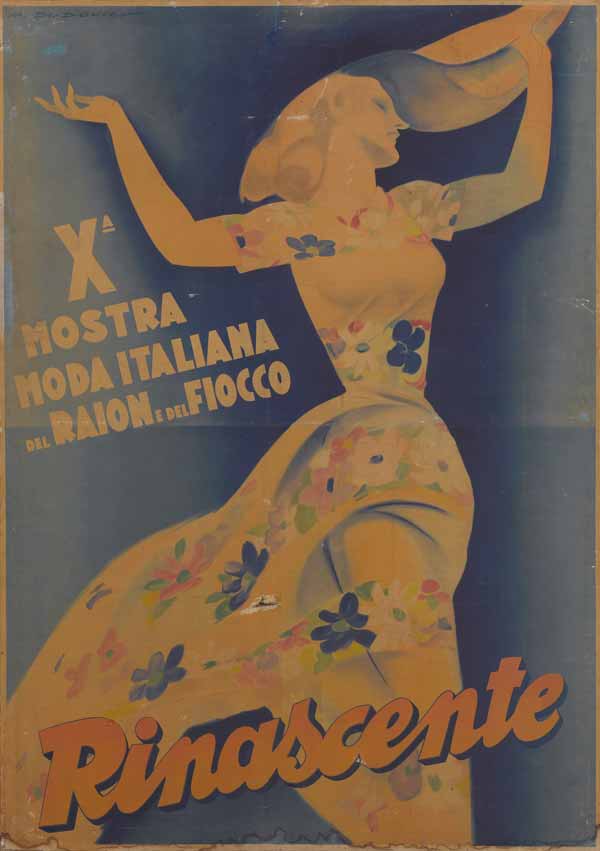
45 — Marcello Dudovich, Rinascente. X mostra moda italiana del raion e del fiocco, 1936 - 1940
Archivio la Rinascente, Milano
La Rinascente promoted campaigns to encourage the consumption of the products of Italian industry, while its distribution forged a vital connection with consumers, learning to interpret the public’s needs.
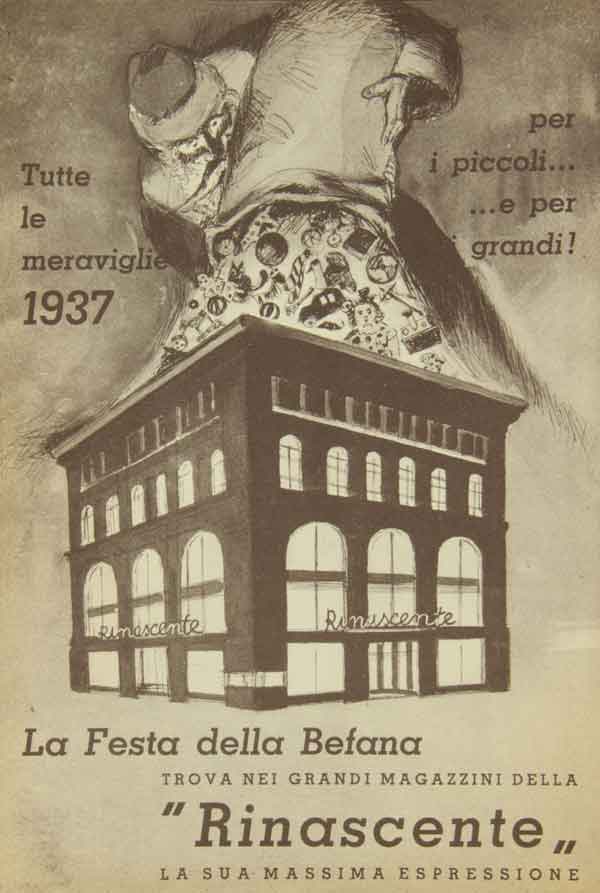
46 — La Festa della Befana, 1937
Collezione Michele Rapisarda, Milano
1940
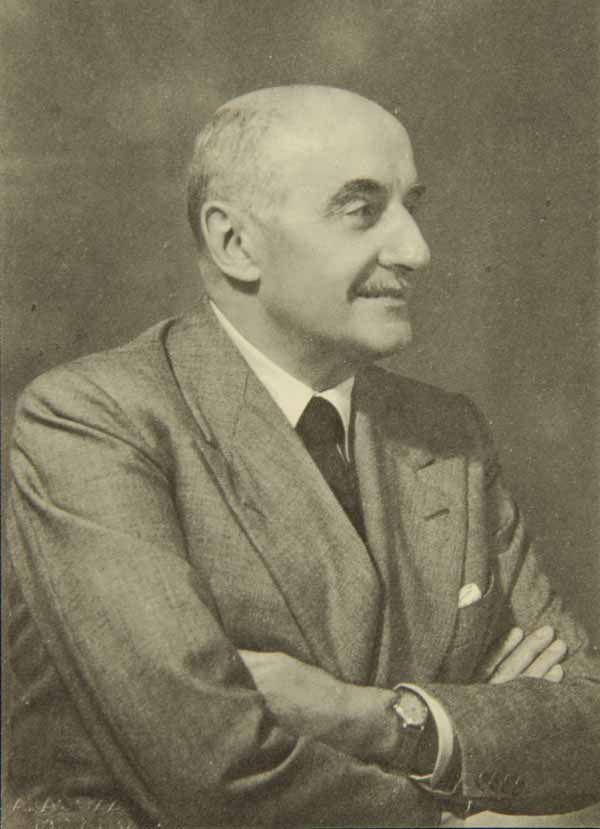
47 — Umberto Brustio, s.d.
Collezione Michele Rapisarda, Milano
Since Senator Borletti had died in 1939, Umberto Brustio was elected President of the company.
In 1941, a decision made by the clothing corporation approved La Rinascente’s superiority to the Standa and Coin stores, which together accounted for half the sales surface area of La Rinascente. In the following year, the twenty-fifth anniversary of its foundation, the company had five La Rinascente stores and fifty-two Upim stores.
1943

48 — Bombardamenti dell’agosto 1943. Nello sfondo, una torretta del palazzo della Rinascente, 1943
Civico Archivio Fotografico, Milano
The war left the company severely damaged, as its stores in Genoa and Cagliari were destroyed. On 16 August, the flagship store in Milan’s Piazza del Duomo was hit by a bombing raid: only one La Rinascente store in Rome and thirty-seven Upim stores scattered all over Italy were still partly operational at this stage.
The city of Milan allowed La Rinascente to rent three large halls in the historical Palazzo della Ragione in Via Mercanti. In 1945 and 1946, nineteen Upim stores, La Rinascente’s branch in Cagliari, the company’s headquarters in Milan’s Via Carducci and the storage facilities were rebuilt.

49 — La terrazza de la Rinascente dopo i bombardamenti, 1943 in “La Rinascente-Upim durante la seconda guerra mondiale 1940-1945”
Archivio Brustio-La Rinascente, Università Commerciale Luigi Bocconi
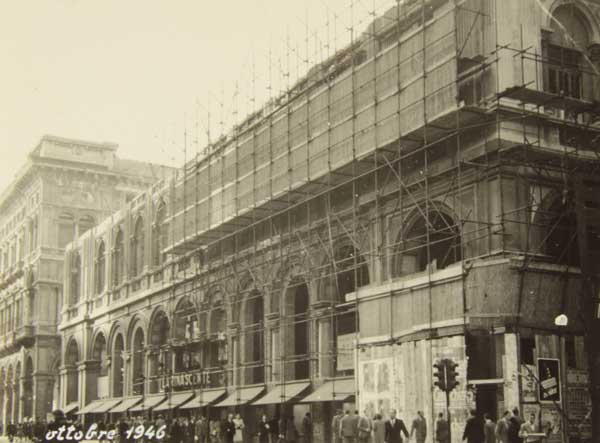
50 — Rifacimento dell'edificio de la Rinascente in Piazza del Duomo, 1946
Archivio Brustio-La Rinascente, Università Commerciale Luigi Bocconi

51 — Demolizione del palazzo de la Rinascente bombardato, 1949
Archivio Brustio-La Rinascente, Università Commerciale Luigi Bocconi
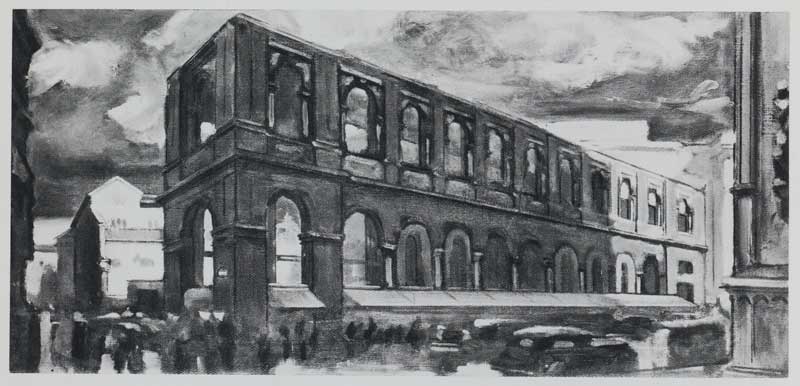
52 — Walter Resentera, La Rinascente, 1946
Illustrazione
Archivio Saporetti Immagini d'Arte, Milano
1950
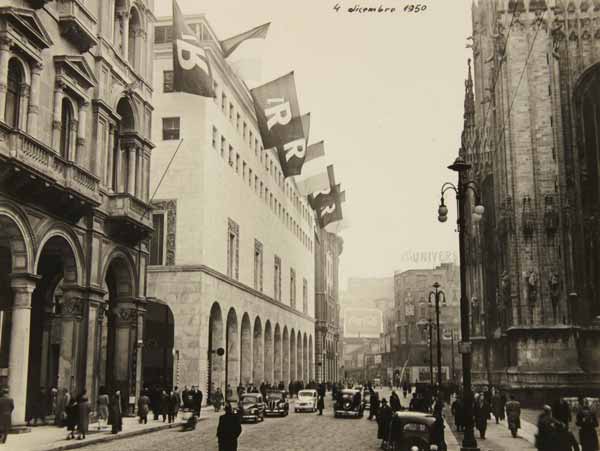
53 — Inaugurazione del nuovo edificio de la Rinascente in piazza del Duomo, 1950
Archivio Brustio-La Rinascente, Università Commerciale Luigi Bocconi
On 4 December, the flagship store in Piazza del Duomo reopened in American style. The architectural design of the building’s exterior was the work of Ferdinando Reggiori, while Carlo Pagani designed the display windows, the entrances, the interior architecture and the décor. Modern escalators provided convenient links between the building’s various floors.
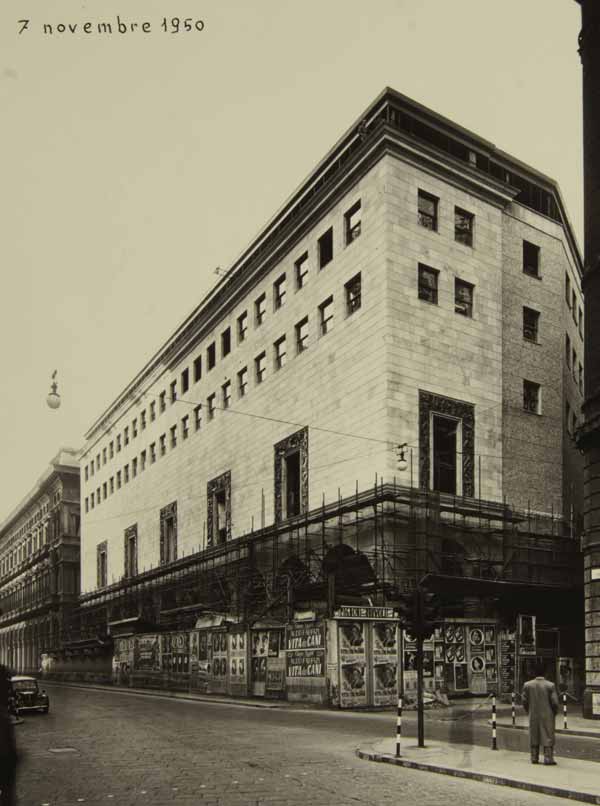
54 — Lavori di ricostruzione della facciata de la Rinascente, 1950
Archivio Brustio-La Rinascente, Università Commerciale Luigi Bocconi

55 — Ricostruzione dell’edificio de la Rinascente a pochi giorni dalla sua inaugurazione, 1950
Archivio Brustio-La Rinascente, Università Commerciale Luigi Bocconi
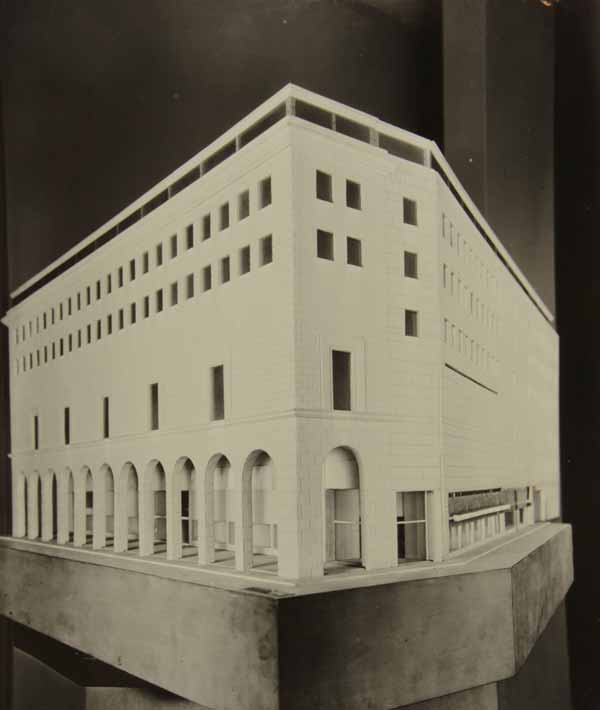
56 — Plastico della nuova sede de la Rinascente in Piazza del Duomo, 1950
Archivio Brustio-La Rinascente, Università Commerciale Luigi Bocconi
Max Huber designed the new lR logo, while Albe Steiner took over and retained responsibility for external and internal display designs and advertising graphics until 1955.
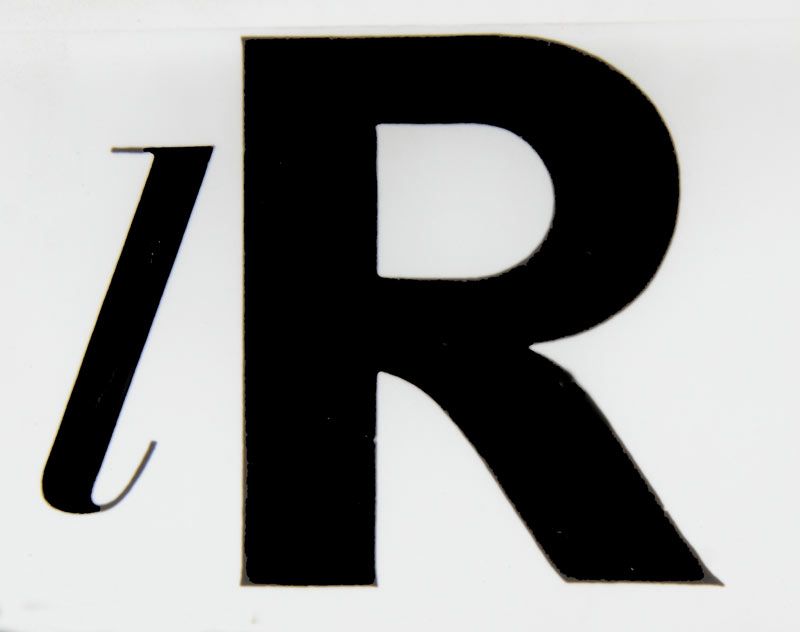
57 — Logo lR disegnato da Max Huber, 1950

58 — Max Huber, 1962
Archivio Max e Aoi Huber, Chiasso

59 — Albe Steiner, R. Si riapre il 4 Dicembre, 1950
Archivio la Rinascente, Milano

60 — Carlo Pagani, Ingresso de la Rinascente di via San Raffaele con il mosaico di Massimo Campigli, 1950
Archivio Carlo Pagani, Milano

61 — Bambini con palloncini pubblicitari de la Rinascente, 1951
Archivi Farabola, Vaiano Cremasco
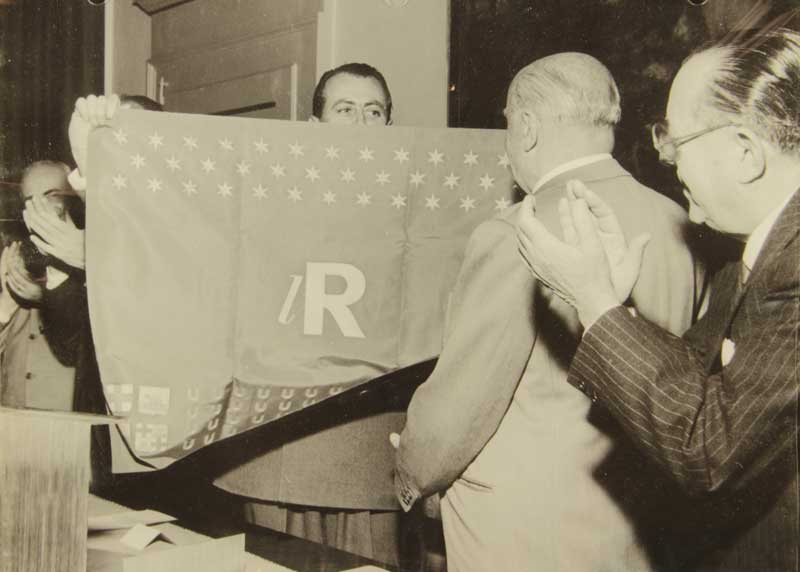
62 — La bandiera de la Rinascente-Upim, realizzata sul modello della bandiera americana per celebrare il numero di filiali aperte, 1957
Archivio Brustio-La Rinascente, Università Commerciale Luigi Bocconi
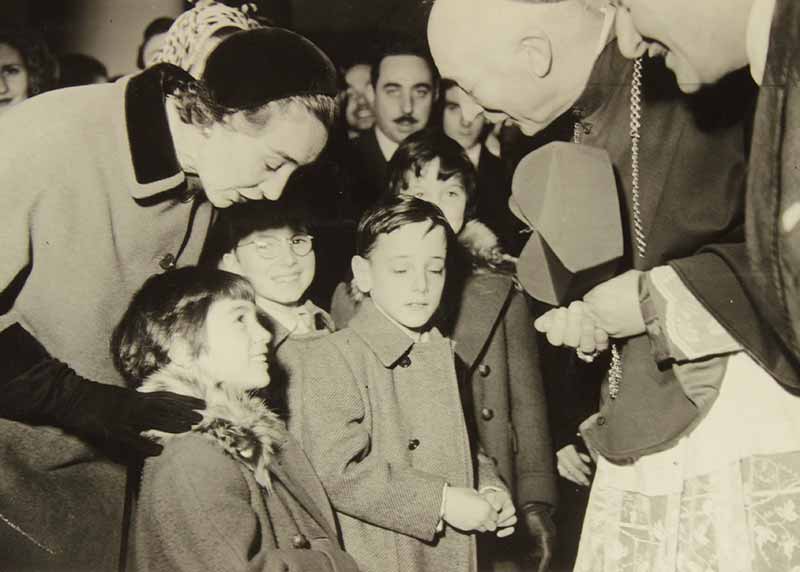
63 — Il Cardinale insieme alla folla il giorno dell'inaugurazione della nuova sede de la Rinascente, 1950
Archivio Brustio-La Rinascente, Università Commerciale Luigi Bocconi
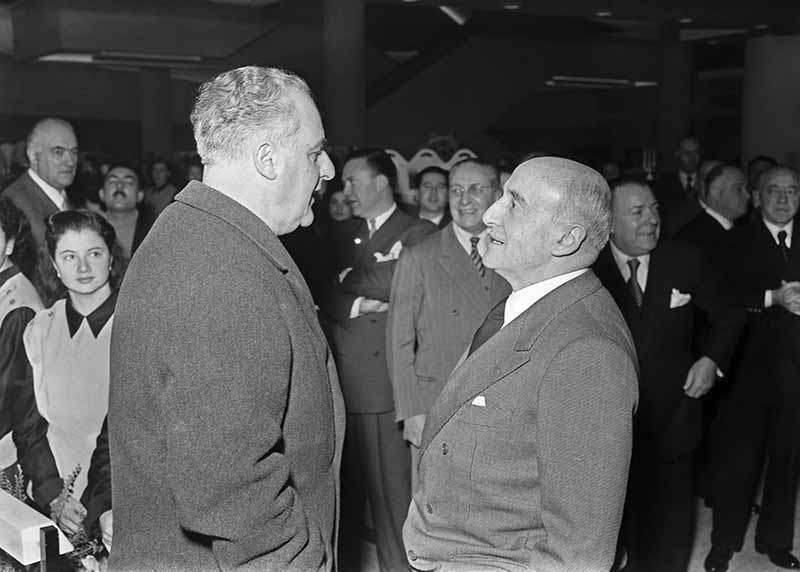
64 — Il Sindaco di Milano Antonio Greppi e il Presidente Umberto Brustio il giorno dell'inaugurazione della nuova sede de la Rinascente, 1950
Archivi Farabola, Vaiano Cremasco
1954

65 — Opuscolo a stampa con illustrazione dei premi, foto delle mostre e dei Compassi d'Oro assegnati nell’edizione del 1954, 1955
Archivio Brustio-La Rinascente, Università Commerciale Luigi Bocconi
La Rinascente established the Compasso d’Oro Award, from a brainchild of Gio Ponti and Alberto Rosselli. Albe Steiner designed the logo and suggested the name for the award.

66 — Il premio Compasso d'Oro assegnato ai produttori nella sua scatola, 1954
Fondazione ADI Collezione Compasso d'Oro, Milano
Lora Lamm was responsible for the advertising graphics, while Amneris Latis was art director in the Advertising Office.
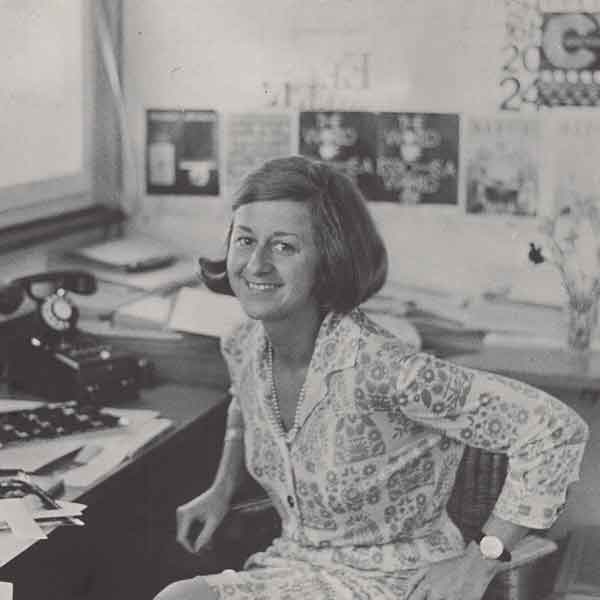
67 — Lora Lamm responsabile della grafica pubblicitaria, 1955 ca., in “La Rinascente: cinquant'anni di vita italiana. Volume secondo”
Archivio Amneris Latis, Milano
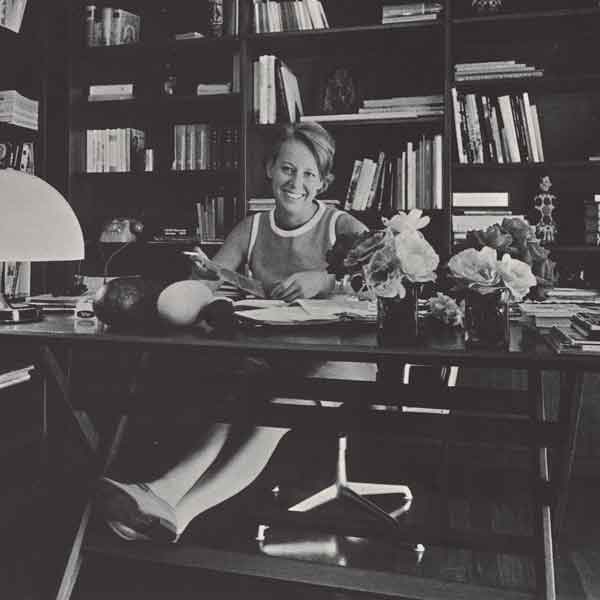
68 — Amneris Latis, art director dell’Ufficio Pubblicità, 1955 ca., in “La Rinascente: cinquant'anni di vita italiana. Volume secondo”
Archivio Amneris Latis, Milano
-alla-premiazione-del-I-Compasso-d'Oro-1954-ce17a03793bd7e5f56080c68daeb3b533b6f6461ad3262af68118e14d998d65f.jpg)
69 — Gio Ponti (in piedi) alla premiazione del I Compasso d'Oro, 1954
Fondazione ADI Collezione Compasso d'Oro, Milano

70 — Mostra dei vincitori del I Compasso d'Oro, allestita da Carlo Pagani e Gian Carlo Ortelli presso la X Triennale, 1954
Fondazione ADI Collezione Compasso d'Oro, Milano
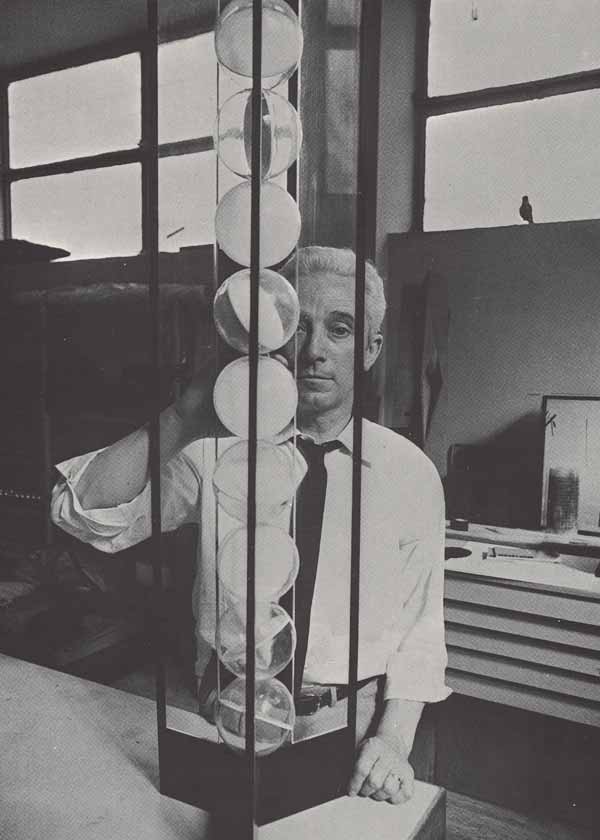
71 — Bruno Munari ideatore del logo Premio Compasso d’Oro, s.d., in “La Rinascente: cinquant'anni di vita italiana. Volume secondo”
Archivio Amneris Latis, Milano
These were years of great ferment: in 1955, the new La Rinascente Social Club was inaugurated in Milan’s Via Durini and the Public Relations Office was established; in 1956 it was the turn of the establishment of the Study Office.
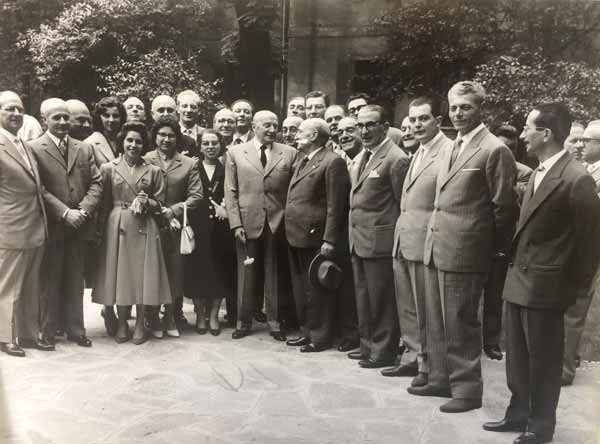
72 — Incontro al Circolo, saluto al Presidente Umberto Brustio, 1957
Archivio Brustio-La Rinascente, Università Commerciale Luigi Bocconi
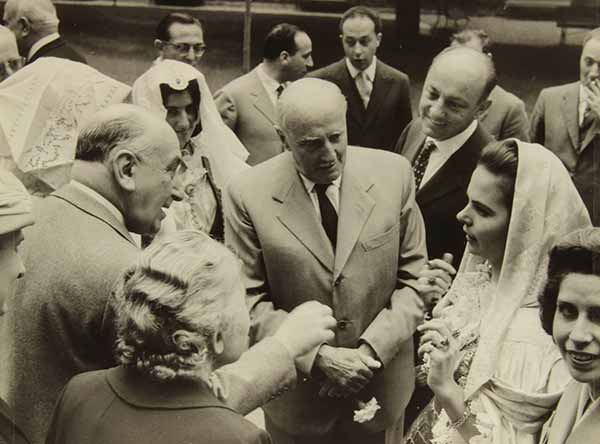
73 — Saluto al Presidente Umberto Brustio, al Circolo, 1957
Archivio Brustio-La Rinascente, Università Commerciale Luigi Bocconi
La Rinascente dedicated an exhibition to Spain. This was followed in subsequent years by exhibitions focusing on Japan (1956), Great Britain (1957), the United States (1958), India and Thailand (1959), Mexico (1960) and the Pre-Columbians (1964).

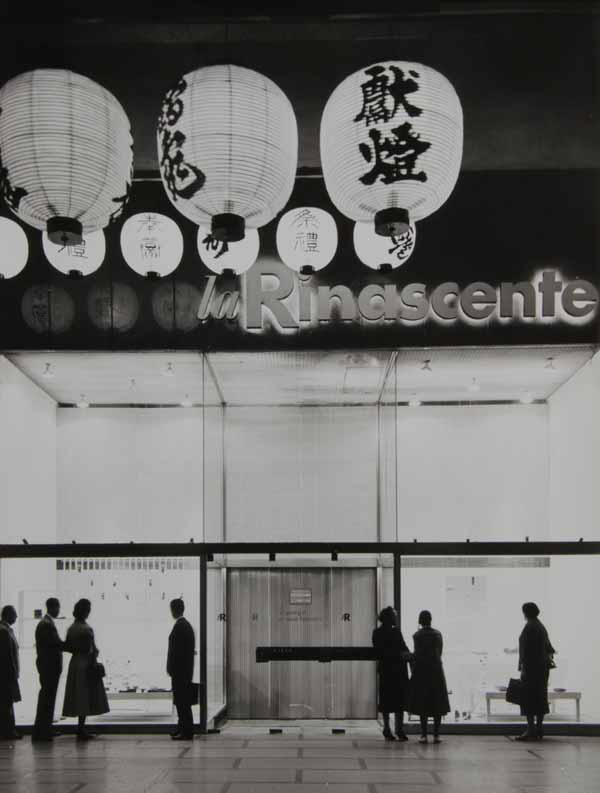
74/75 — La Rinascente Grandi manifestazioni, “Il Giappone”, esterno, 1956
Archivio Amneris Latis, Milano
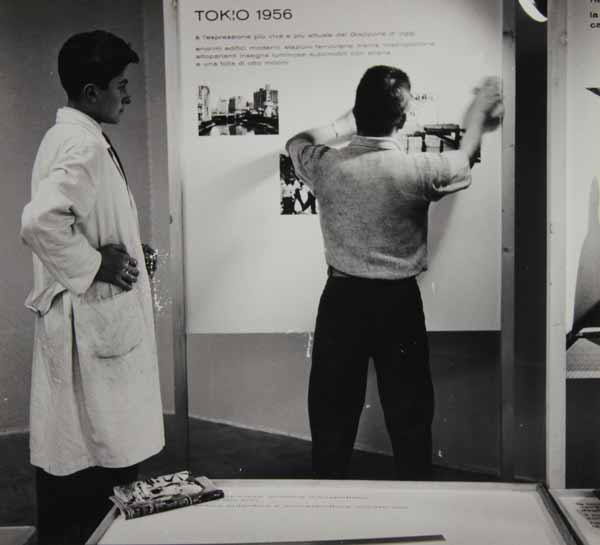
76 — Allestimento de la Rinascente Grandi manifestazioni, “Il Giappone”, 1956
Archivio Amneris Latis, Milano
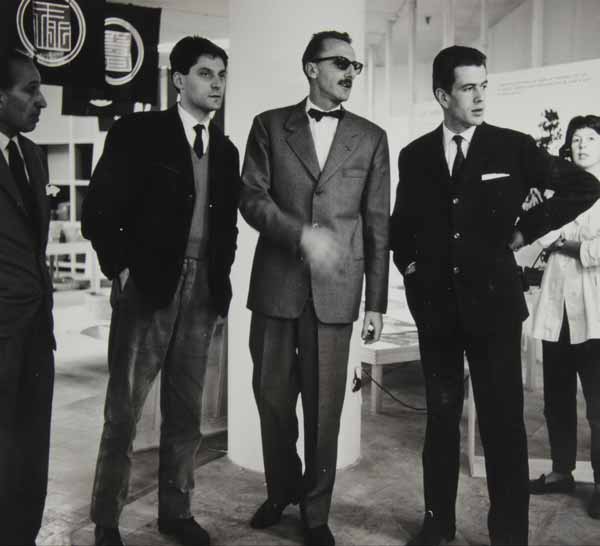
77 — Gian Carlo Ortelli e Giovanni Bordoli alla mostra La Rinascente Grandi Manifestazioni, “Il Giappone”, 1956
Archivio Amneris Latis, Milano
1957

78 — I due Presidenti: congedo del Sig. Umberto Brustio con sua nomina a Presidente Onorario e il nuovo Presidente Dott. Romualdo “Aldo” Borletti, 1957
Archivi Farabola
Umberto Brustio retired as the company’s top manager after nearly forty years at the helm, accepting the position of Honorary President.
Senator Borletti’s son Aldo was elected company president and also held the position of general manager, together with Cesare and Giorgio Brustio. The most important individual in the company’s top management was Cesare Brustio, general manager and company vice-president.
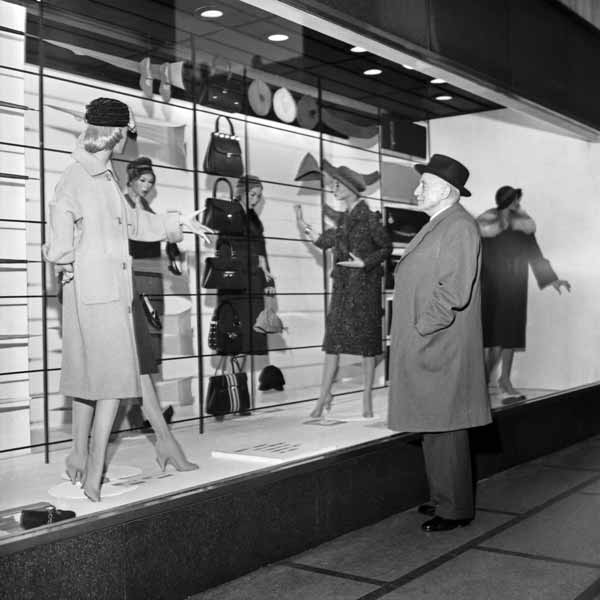
79 — Il Presidente onorario Umberto Brustio davanti alle vetrine de la Rinascente, 1958
Archivi Farabola
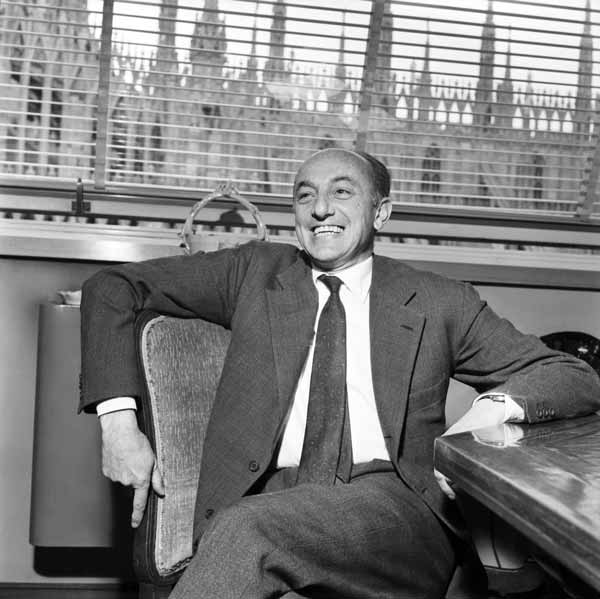
80 — Cesare Brustio nel suo ufficio presso la Rinascente, 1957
Archivi Farabola
1959
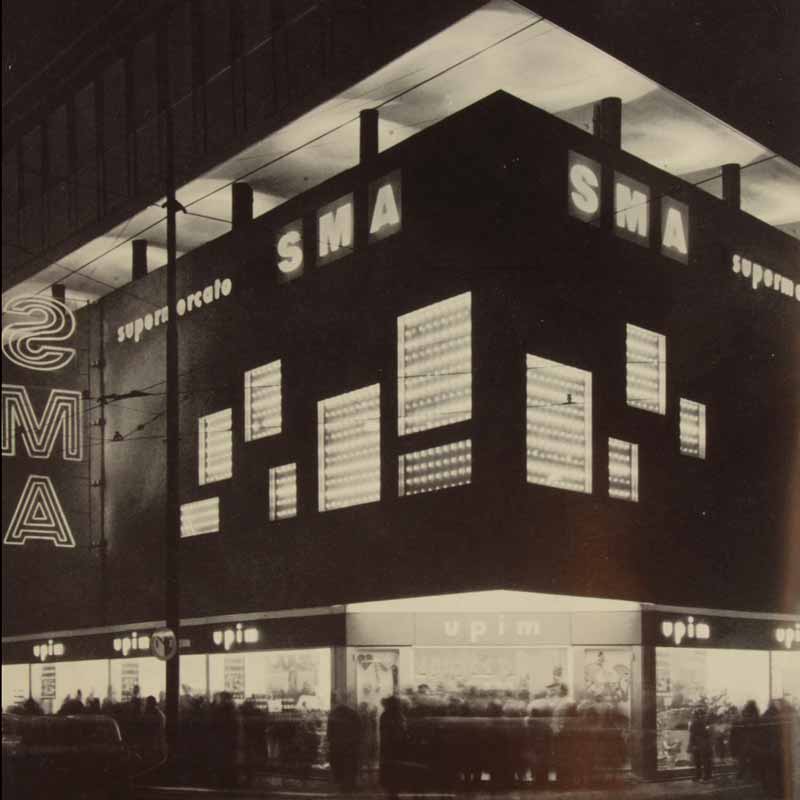
81 — Supermercato SMA, in “Prospettive e programmi della Upim”, 1964
Archivio Brustio-La Rinascente, Università Commerciale Luigi Bocconi
Building on the model of the first supermarket opened in Italy on 27 November 1957 in Milan’s Viale Regina Giovanna, the La Rinascente-Upim conglomerate now added to its activities by launching the SMA chain of supermarkets, the most modern and up-to-date model of distribution and retail sales for foodstuffs.

82 — Supermercato SMA in via Padova a Milano, in “La Rinascente Upim”, 1969
Archivio Brustio-La Rinascente, Università Commerciale Luigi Bocconi

83 — Logo SMA supermercati, 1960 ca., in “La Rinascente: cinquant'anni di vita italiana. Volume terzo”
Archivio Amneris Latis, Milano
This was the year when the economic boom really took off: during the Christmas rush, the Milan La Rinascente store had to close its doors in an effort to control the crush of Christmas shoppers inside the building.

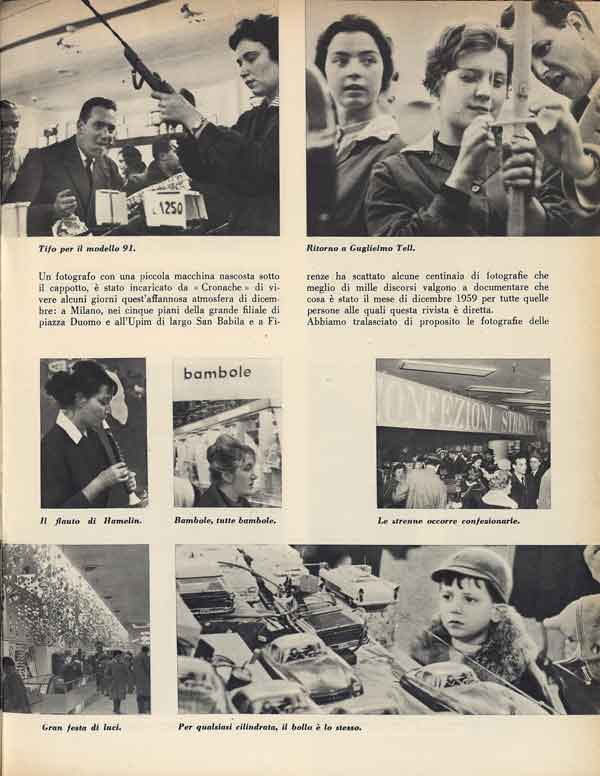
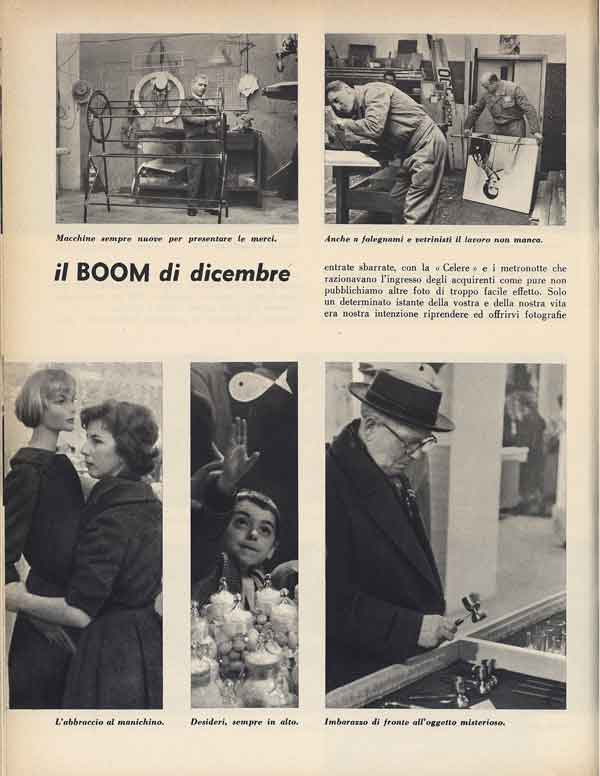
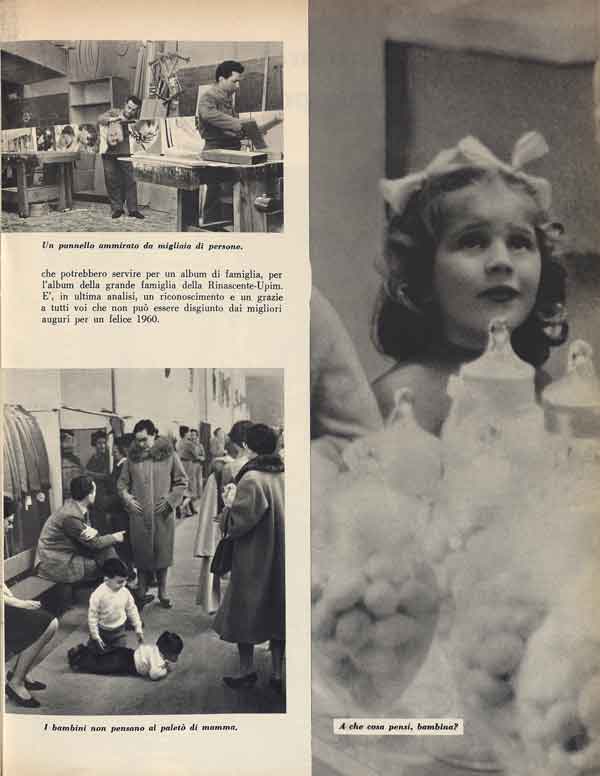
84/85/86/87 — Il Boom Economico di dicembre, in “Cronache Rinascente-Upim”, a. XIII, n. 17, 1959
1961
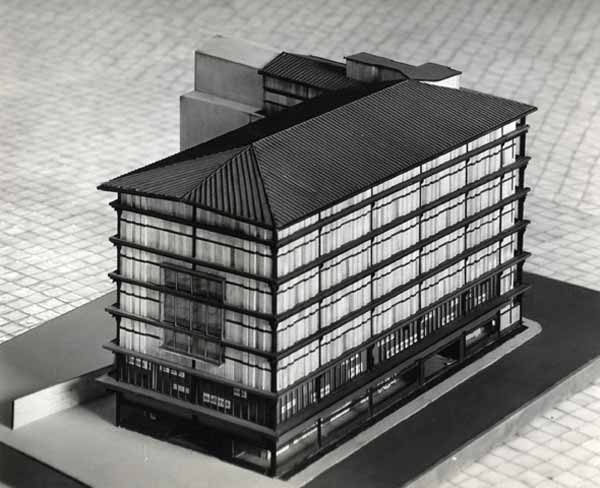
88 — Franco Albini, Modello in scala del secondo progetto dell'Edificio de la Rinascente in piazza Fiume, 1960
Fondazione La Triennale di Milano - Biblioteca del Progetto e Archivio Storico
La Rinascente opened its store in Piazza Fiume, Rome, designed by Franco Albini and Franca Helg.
The building has almost no windows at all, so as to enable the best possible use of the interior space, to the benefit of the displays. The store occupies seven floors linked together by lifts and escalators, while 50 sales departments presented all the variants on assortments already familiar from the flagship store in Milan. This made La Rinascente Rome’s most comprehensive shopping centre.


89 — La nuova modernissima Rinascente piazza Fiume si affianca alla tradizionale simpatica Rinascente piazza Colonna, 1961
Archivio Amneris Latis, Milano
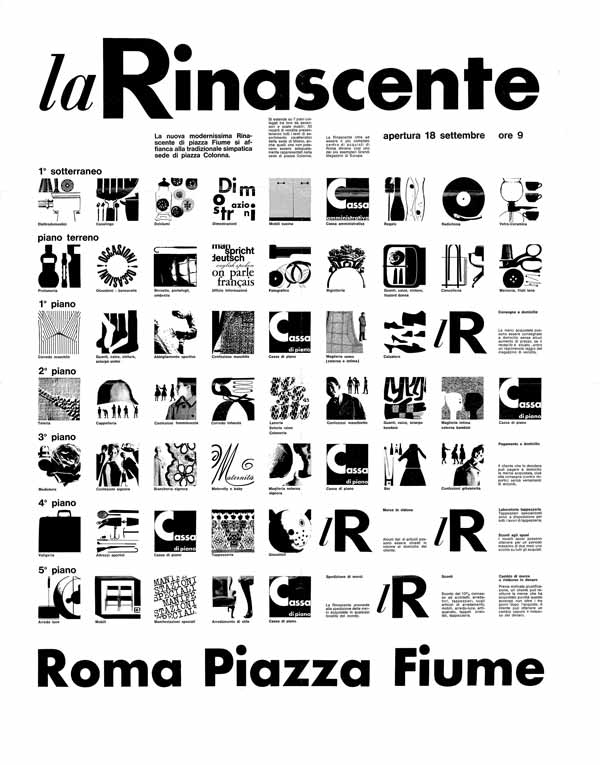
90 — La Rinascente, Roma piazza Fiume. Apertura 18 settembre, 1961
Archivio Gian Carlo Ortelli, Milano

91 — La scala della nuova Rinascente in piazza Fiume, 1961, in “Albini Helg. La Rinascente. Il progetto di architettura. Disegni e progetto de la Rinascente di Roma”, 1982
Archivio Italo Lupi, Milano
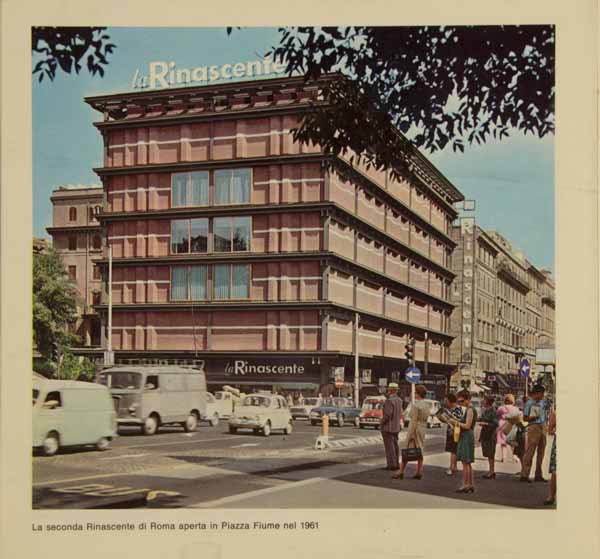
92 — La Rinascente, Roma Piazza Fiume, in “La Rinascente Upim”, 1969
Archivio Brustio-La Rinascente, Università Commerciale Luigi Bocconi
1963

93 — Pierre Cardin alla Rinascente, in “Cronache laRinascente upim”, a. XVI, n. 31, 1963
The celebrated French fashion designer Pierre Cardin signed a contract with La Rinascente to produce a line of his clothing at affordable prices, declaring that fashion should be accessible to everyone, democratic and in step with the times.
Adriana Botti Monti became art director for the Advertising Office. The numerous awards and professional acknowledgements she won were to be the milestones marking her career.

94 — Illustrazione di Brunetta Meteldi, in “Cronache la Rinascente-Upim”, a. XII, n.15, 1959
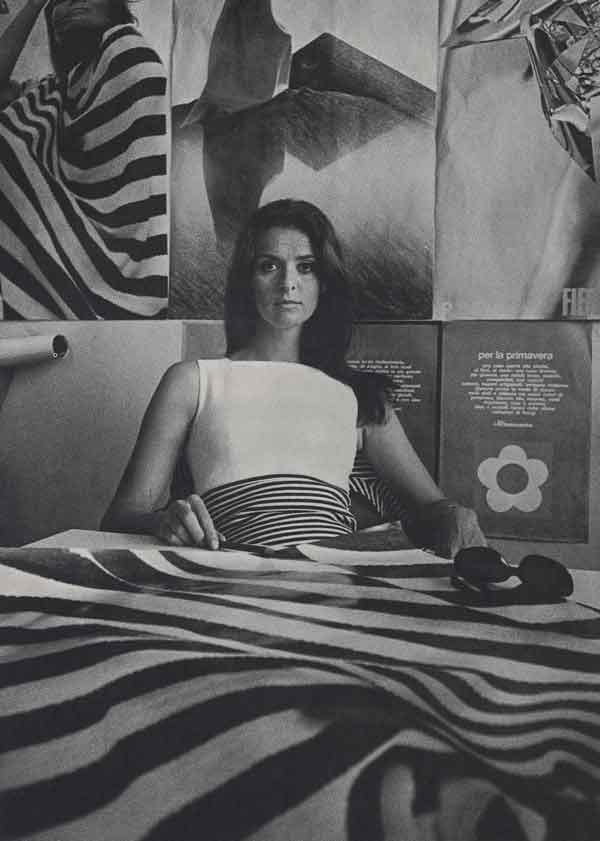
95 — Adriana Botti Monti, art director Ufficio Pubblicità, in “La Rinascente: cinquant'anni di vita italiana. Volume secondo”
Archivio Amneris Latis, Milano
1969
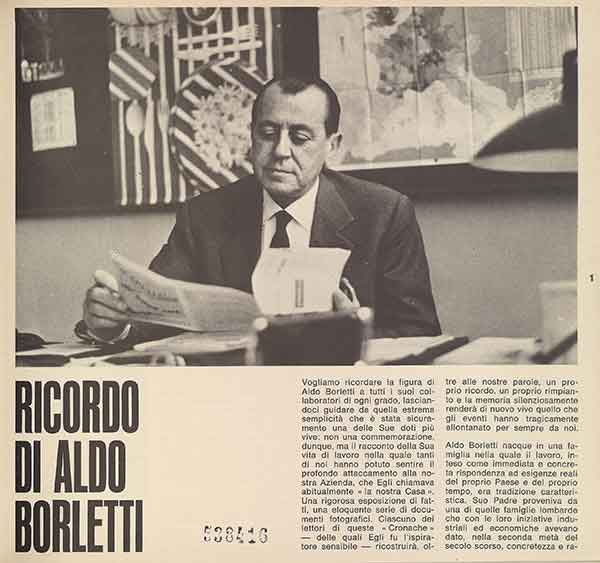
96 — Ricordo di Aldo Borletti, in “Cronache laRinascente upim”, a. XX, n. 43, 1967-1968
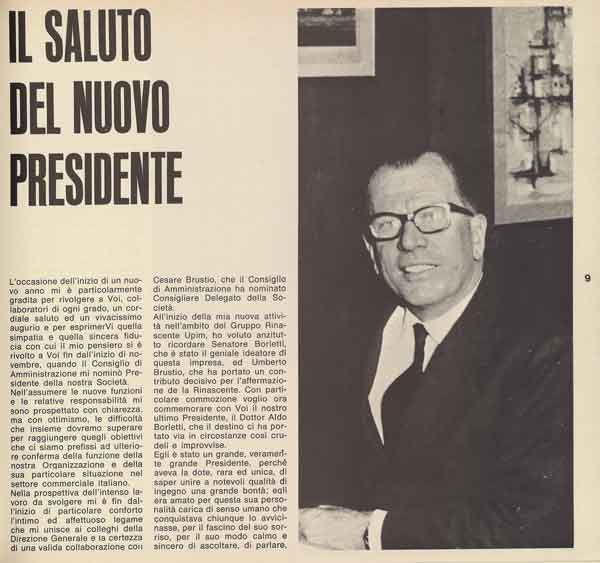
97 — Il saluto del nuovo presidente Senatore Borletti, in “Cronache laRinascente upim”, a. XX, n. 43, 1967-1968
When Aldo Borletti passed away in 1967, the new president of the group was Senatore Borletti Jr., while Cesare Brustio held the office of managing director.
The Borletti family sold its shareholdings to IFI, in the FIAT group, and Mediobanca, who had already held shares since 1965, when Jelmoli had left the company. In 1970, the ambassador Guido Colonna di Paliano was appointed the new president of the company.
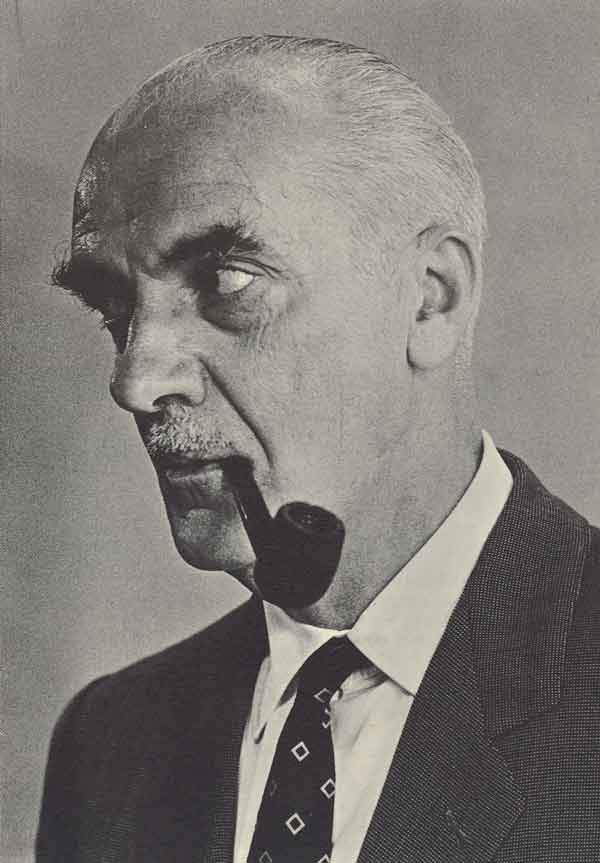
98 — Guido Colonna di Paliano, presidente del gruppo “la Rinascente”, in “Cronache gruppo laRinascente”, a. XXIII, n. 56, 1970.
The group now had five La Rinascente stores, 150 UPIM stores and fifty-four SMA supermarkets.
1972

99 — La Rinascente Città Mercato, in “Cronache laRinascente upim”, a. XXV, n. 68, 1972
La Rinascente-Città Mercato was opened in Brescia, the first hypermarket devoted to selling goods at affordable prices. The aim of the company’s new management was to overcome the divide between mass distribution and traditional commerce.
The flagship store in Piazza Duomo was renewed and the new structure for La Rinascente in the 1970s was rational and in line with the times. In 1973, La Rinascente inaugurated its store in Turin.
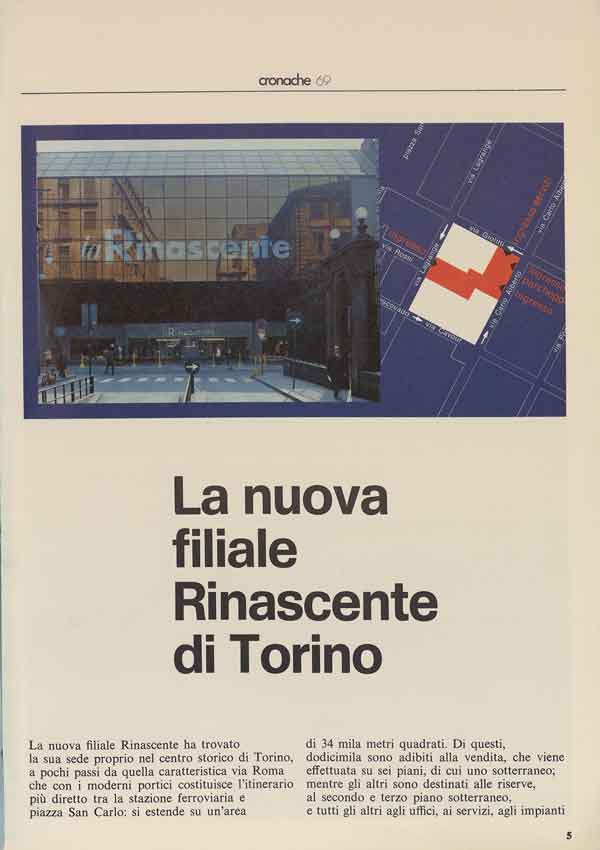

100 — La nuova filiale Rinascente di Torino, in “Cronache della Rinascente-Upim”, a. XXVI, n. 69, 1973
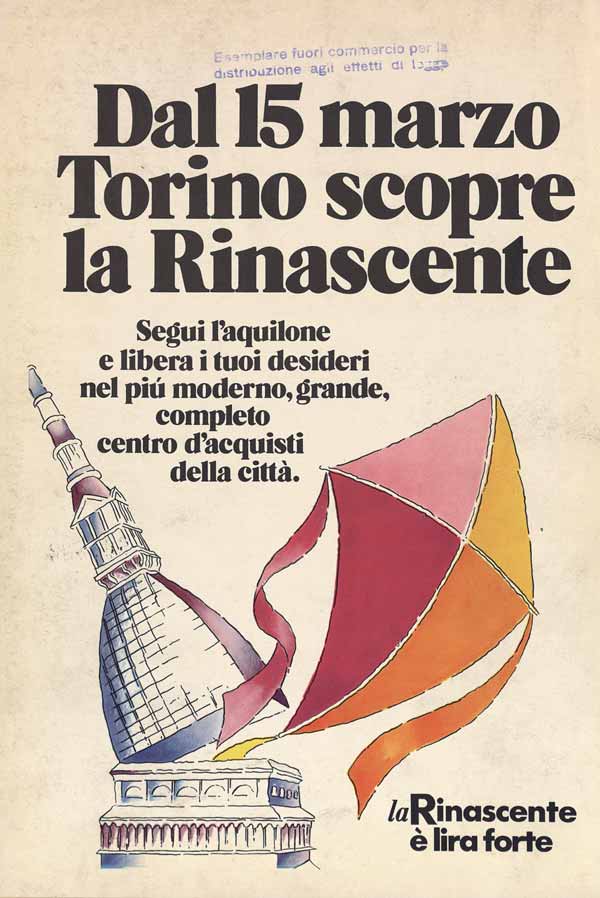
101 — Dal 15 marzo Torino scopre la Rinascente, in “Cronache della Rinascente-Upim”, a. XXVI, n. 69, 1973
Umberto Brustio died on 25 April 1972. On 23 March 1973, Senatore Borletti Jr. was appointed company vice-president.
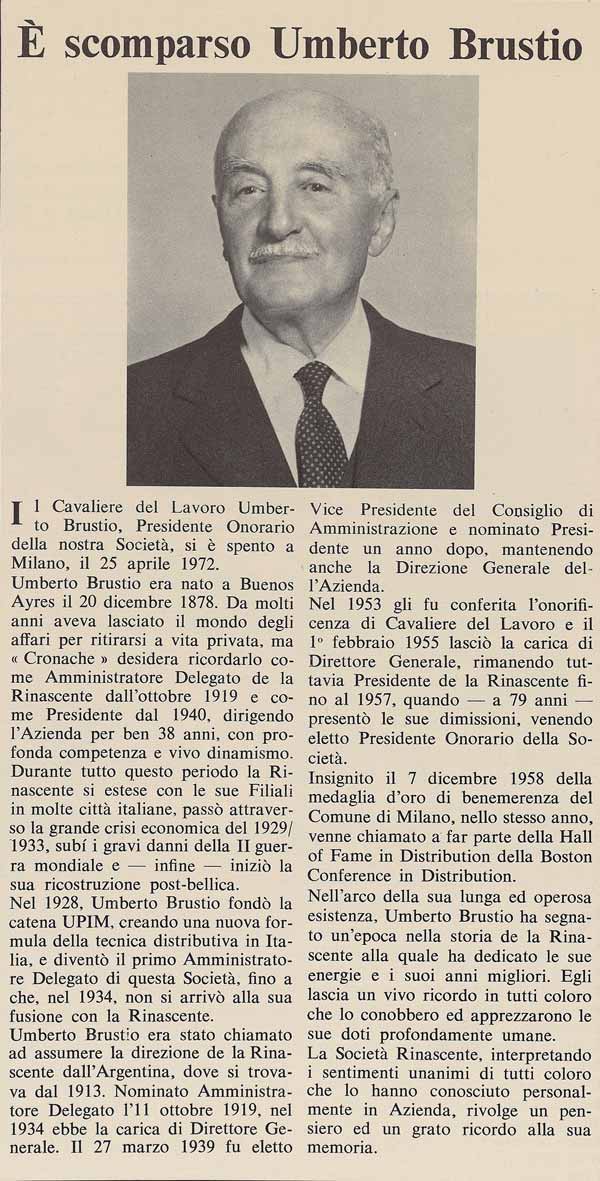
102 — E’ scomparso Umberto Brustio, in “Cronache della Rinascente-Upim”, a. XXV, n. 65, 197
1977
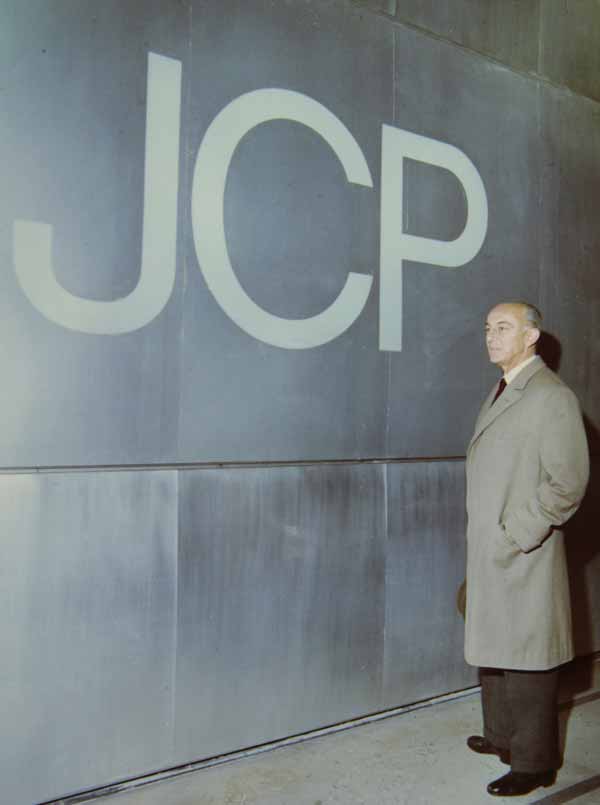
103 — Cesare Brustio davanti ai magazzini JCPenney, 1976
Fondazione La Triennale di Milano - Archivio Paola Lanzani
The group took over the Italian stores owned by one of the United States’ largest distribution firms, J.C. Penney, which had four points of sale in Lombardy. Benefitting from its experience in distribution networks and modern organisation, as well as from the company’s success, La Rinascente was now focused on reviving its fortunes: in the first half of this year, it increased its sales by 20.7%.
Afterwards 1983, the group opened Italy’s first Bricocenter, a supermarket for do-it-yourself enthusiasts, in Turin. Two years later, it concluded negotiations to take over Croff Nuova SpA, a company specialised in distributing products for the home.

104 — Croff centro casa Cagliari, 1976
Fondazione La Triennale di Milano - Archivio Paola Lanzani
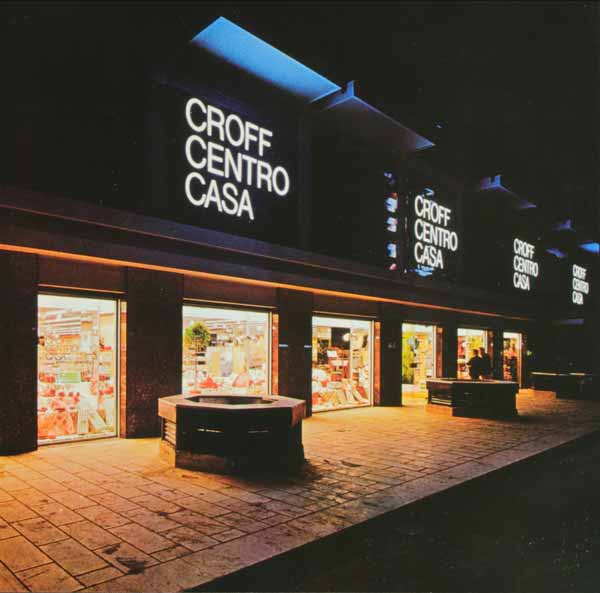
105 — Croff centro casa, 1976
Fondazione La Triennale di Milano - Archivio Piercarla Toscano Lanzani Racchelli
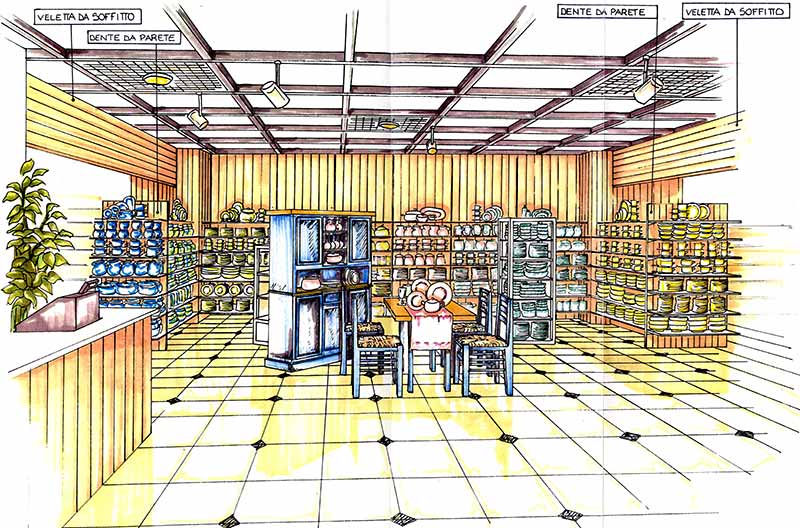
106 — Croff Centro Casa, nuova immagine per la catena di negozi, 1985-1990
Fondazione La Triennale di Milano - Archivio Piercarla Toscano Lanzani Racchelli
1997
The FIAT group, which owned La Rinascente, concluded a financial and technical agreement with the French Auchan group, which led to the launch of a process of conversion of La Rinascente’s twenty-three Città Mercato stores and two Joyland stores into Auchan outlets. The group ended the year with an increase in turnover and developed new strategies to reach its objective of strengthening its foodstuffs sector by opening forty hypermarkets by the end of 2002.

107 — Le Collezioni Rinascente, 1995
Archivio la Rinascente, Milano
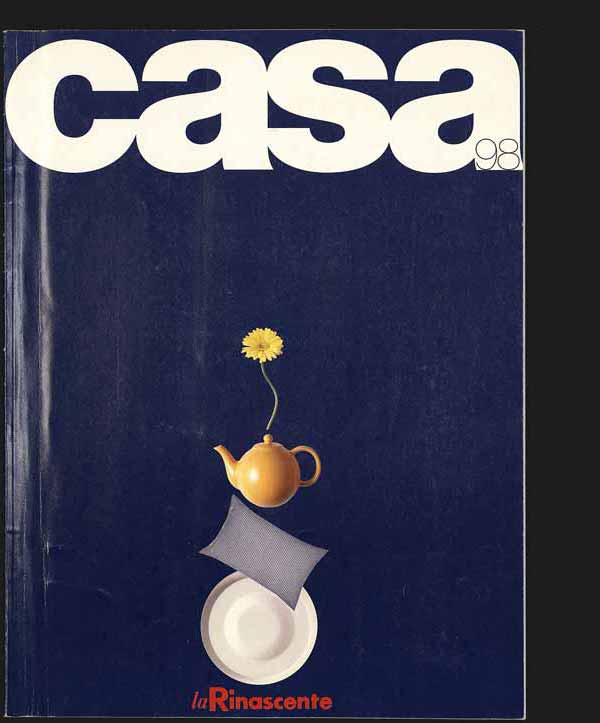
108 — Casa 98, la Rinascente, 1998
Archivio la Rinascente, Milano
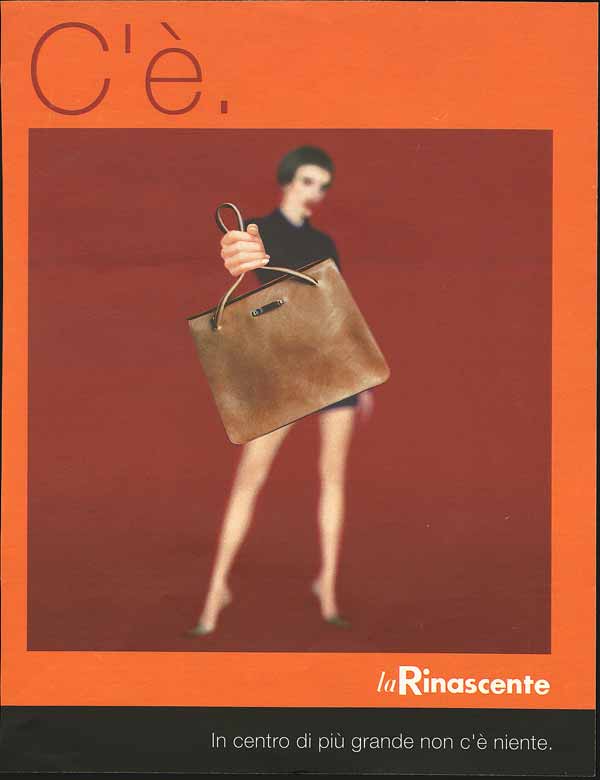
109 — C’è. La Rinascente, 1998
Archivio la Rinascente, Milano
2005

110 — Vittorio Radice
Archivio la Rinascente, Milano
Following a group divestment, the major department store La Rinascente was taken over by a group of investors (20% Pirelli Real Estate, 46% Investitori Associati, 30% Deutsche Bank, 4% Borletti family), who created La Rinascente SpA. The new management team was led by Vittorio Radice.
In 2007, the Food Hall was opened on the seventh floor of the Milan flagship store, followed in 2009 by the Design Supermarket.
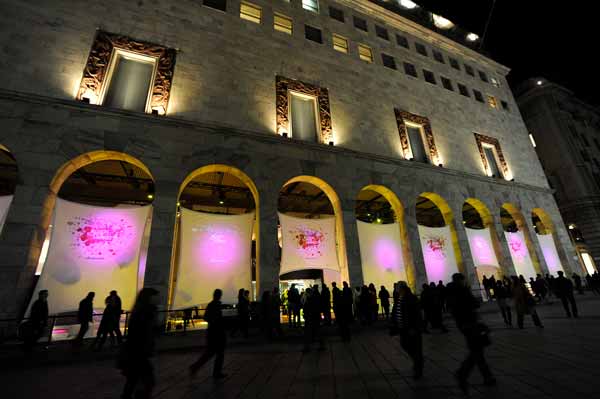
111 — La Rinascente, esterno
Archivio la Rinascente, Milano

112 — Design Supermarket, la Rinascente Milano
Archivio la Rinascente, Milano
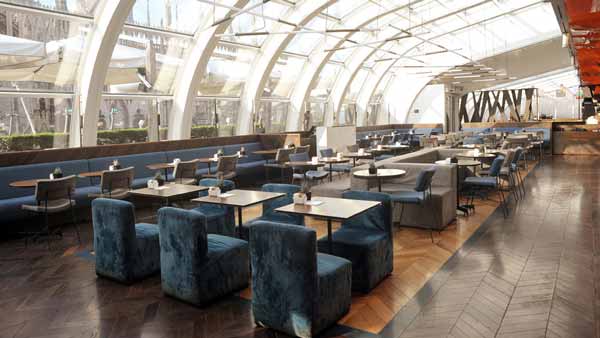
113 — Food Hall, la Rinascente Milano
Archivio la Rinascente, Milano
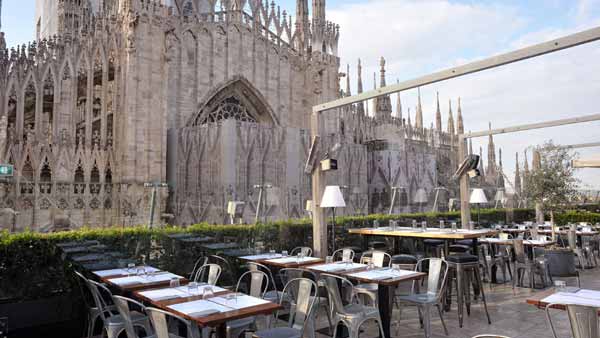
114 — Food Hall, la Rinascente Milano
Archivio la Rinascente, Milano
2011
-0bd2d247d145fb8a87fc3c76ee0be87775a901ea20e5cdb350f56ff3e851055e.jpg)
115 — Alberto Baldan e Sudhitham Chirathivat
Archivio la Rinascente, Milano
In May 2011, the thai company Central Retail Corporation took over ownership of La Rinascente. Sudhitahn Chirathivat became president and Tos Chirathivat was director of La Rinascente. In particular Tos Chirathivat announced in a press conference he desire to make La Rinascente known around the world nd across all of Asia. The following year, Alberto Baldan – general director since 2007 - became CEO. Vittorio Radice was then appointed vice-president of La Rinascente, along with his task of the group’s luxury department stores international development.
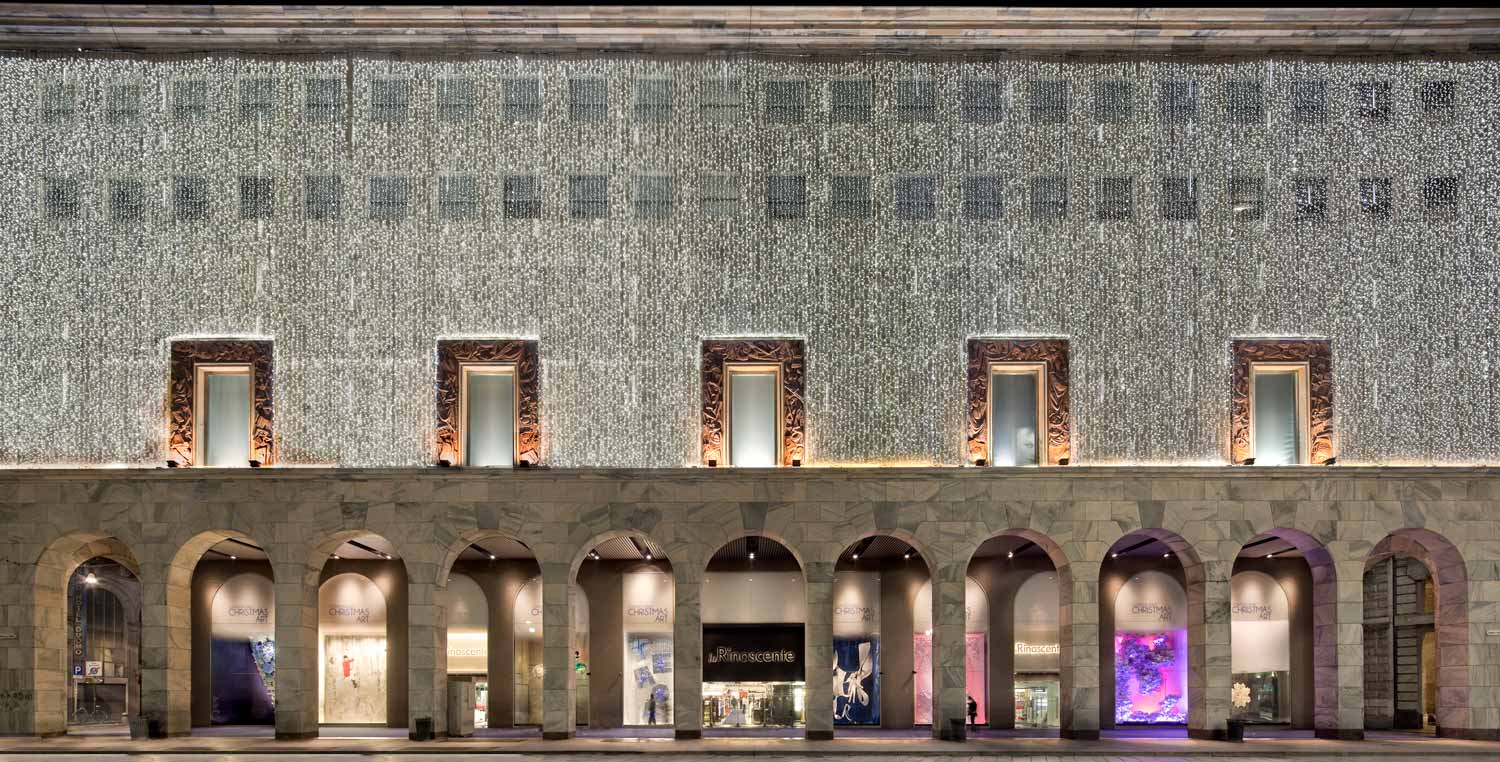
116 — La Rinascente, facciata, 2010
Archivio la Rinascente, Milano
2016

117 — La Rinascente nominata “Miglior Department Store al mondo”, 2016
Archivio la Rinascente, Milano
On 26 May, Milan’s La Rinascente, which in the previous year had celebrated the 150th anniversary of the Bocconi’ brothers’ first store and whose Central group had meanwhile taken over the Illum department store in Copenhagen (2013) and KaDeWe in Berlin (2015), won an award as the World’s Best Department Store during the ceremony for the Global Department Store Summit 2016 held in Zürich.

118 — Vetrine de la Rinascente di Milano, dedicate a Madama Butterfly, 2016
Archivio la Rinascente, Milano
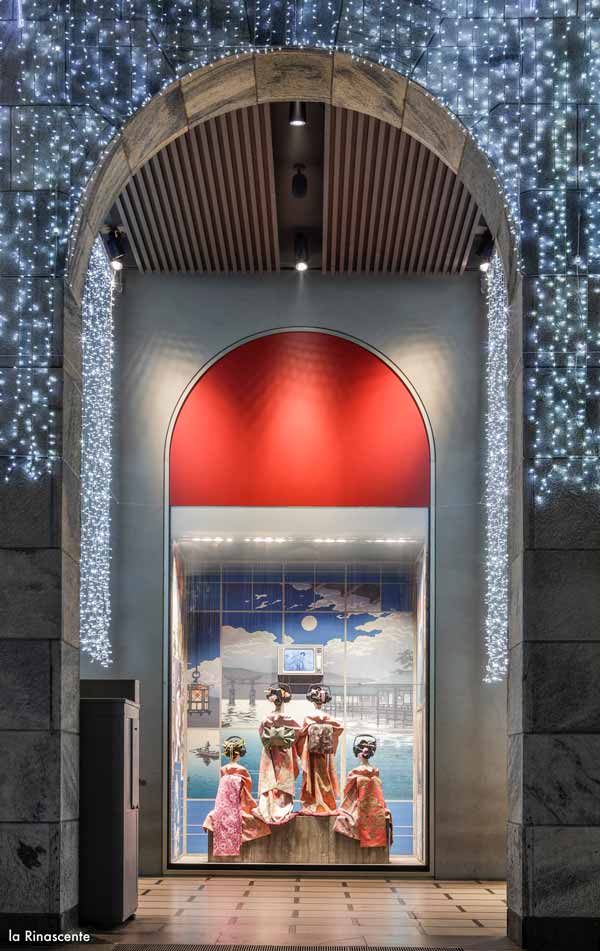
119 — Vetrine de la Rinascente di Milano, dedicate a Madama Butterfly, 2016
Archivio la Rinascente, Milano
2017

120 — lR100. Rinascente. Stories of innovation, 2017
Rinascente Archives
In 2017, to celebrate the centenary of its name coined by Gabriele D’Annunzio, Rinascente set up an exhibition at Palazzo Reale called “LR100. Rinascente. Stories of Innovation”. Design, fashion, art and communication played a central role through a journey that showed how Rinascente created new paradigms of style, and encouraged the creation of production systems for the fashion and design industries.
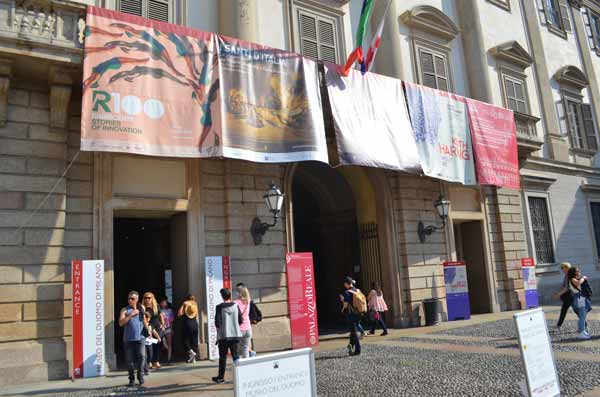
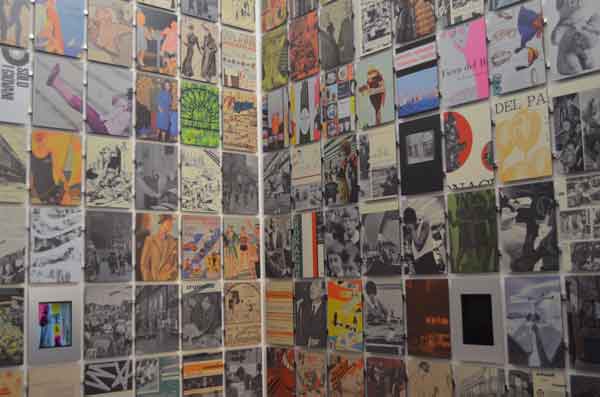
121/122 — lR100. Rinascente. Stories of innovation, 2017
Rinascente Archives
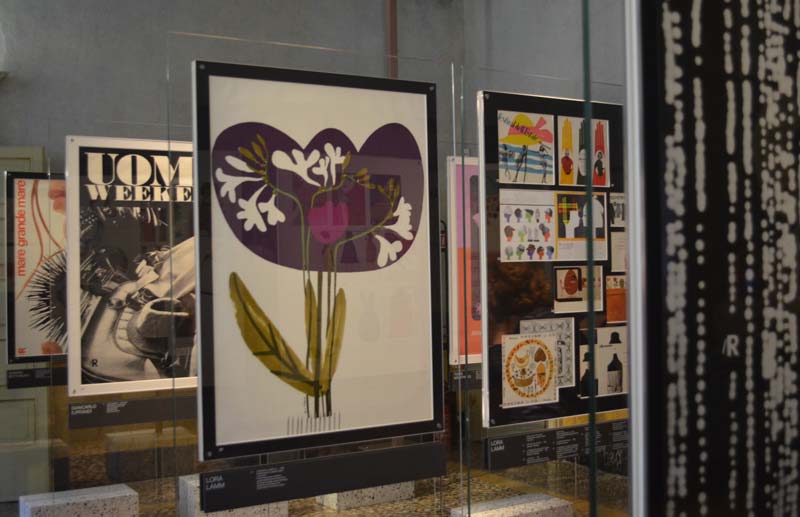
123 — lR100. Rinascente. Stories of innovation, 2017
Rinascente Archives

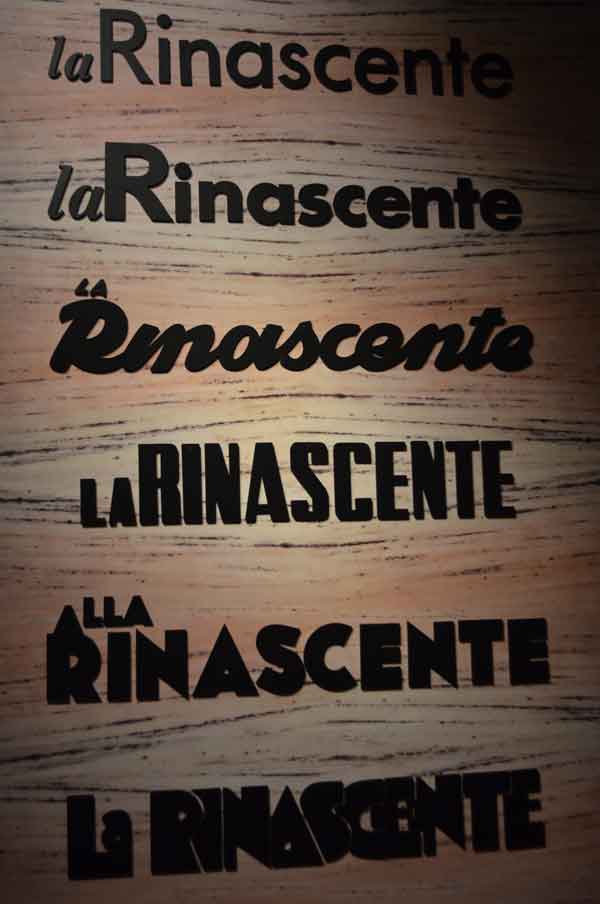

124/125/126 — lR100. Rinascente. Stories of innovation, 2017
Rinascente Archives
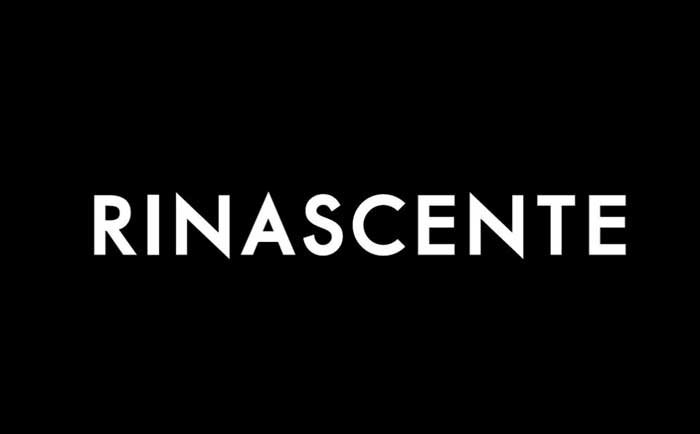
127 — Il nuovo Logo Rinascente, 2017
Archivio la Rinascente, Milano
In September, Rinascente revealed its new logo, completely written in capital letters, without the article ‘La’. The design was created by North Design, an English studio specialising in visual identity, and has a modern and fresh style.
In October, the second flagship store was inaugurated in Rome, in via del Tritone. The store is spread across eight floors in a completely renovated building, where the spotlight is on the historic and cultural treasures of the territory, such as the archaeological site of the Aqua Virgo aqueduct, first used in 19 BC. The store embeds a small building from the early 20th century, known as “Palazzetto”. The top floor houses a Food Hall that gives visitors a one-of-a-kind view over the roofs of the Eternal City.
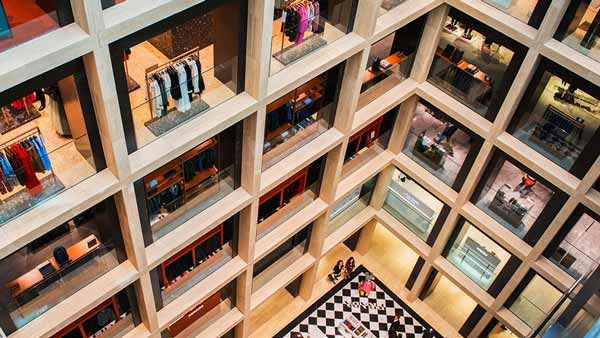

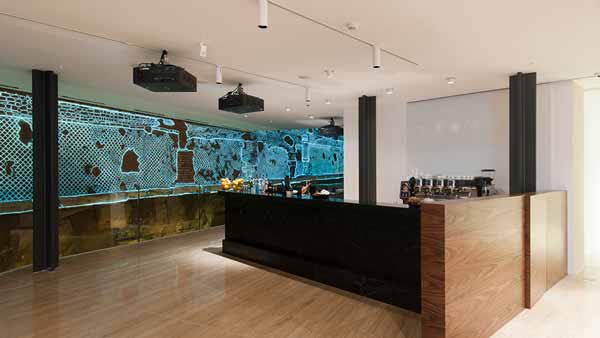
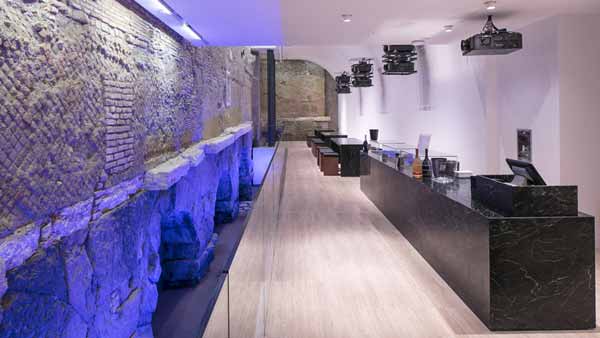
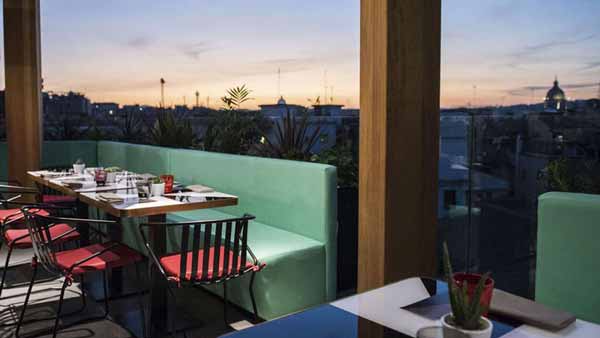

128/129/130/131/132/133 — La Rinascente, Roma via del Tritone, 2017
Archivio la Rinascente, Milano